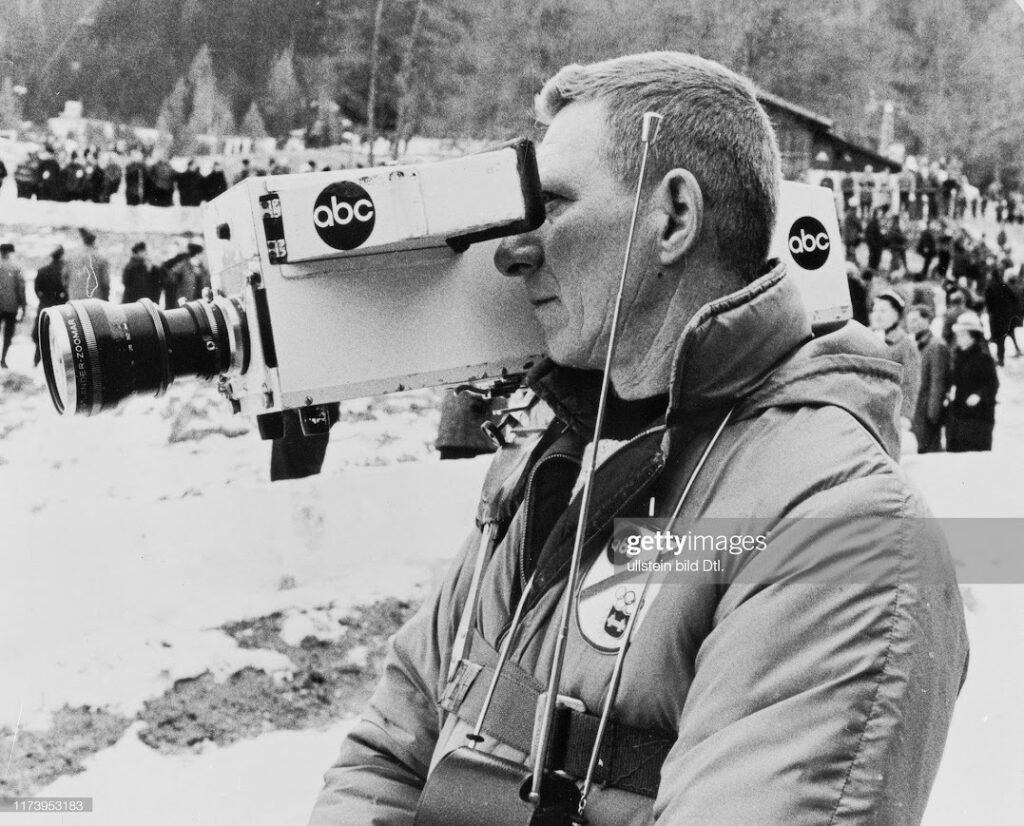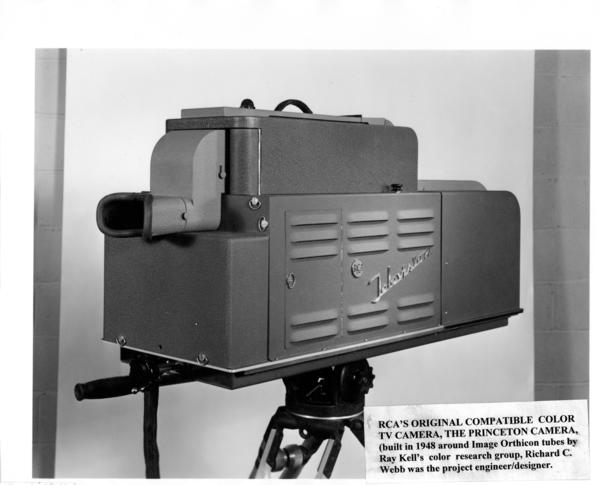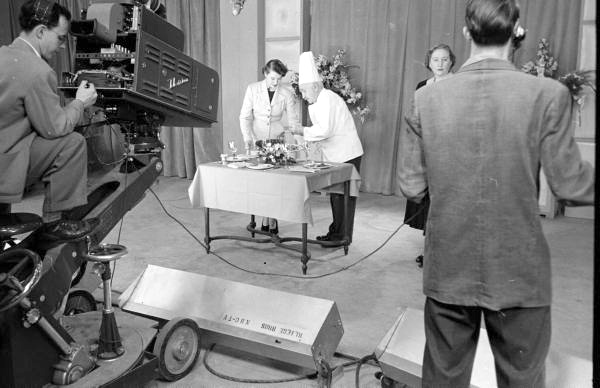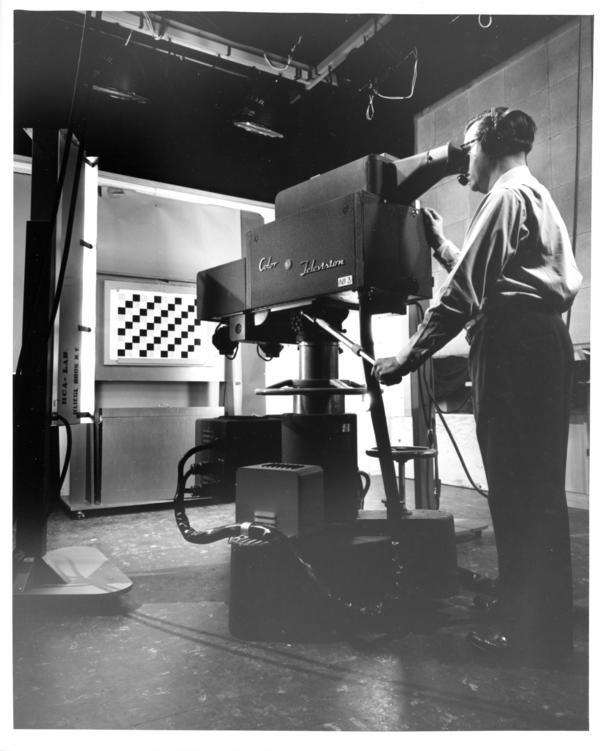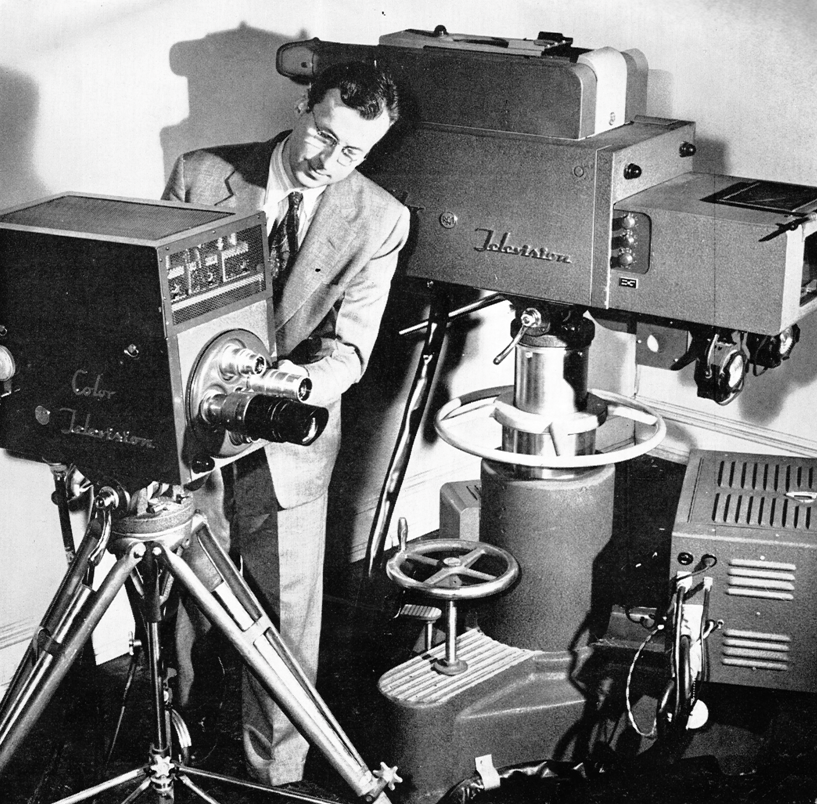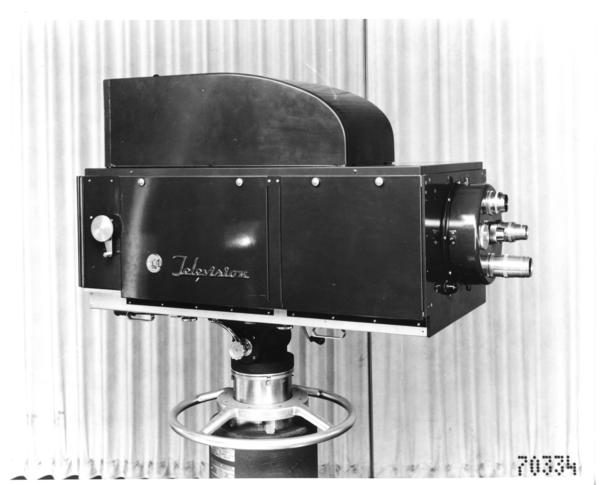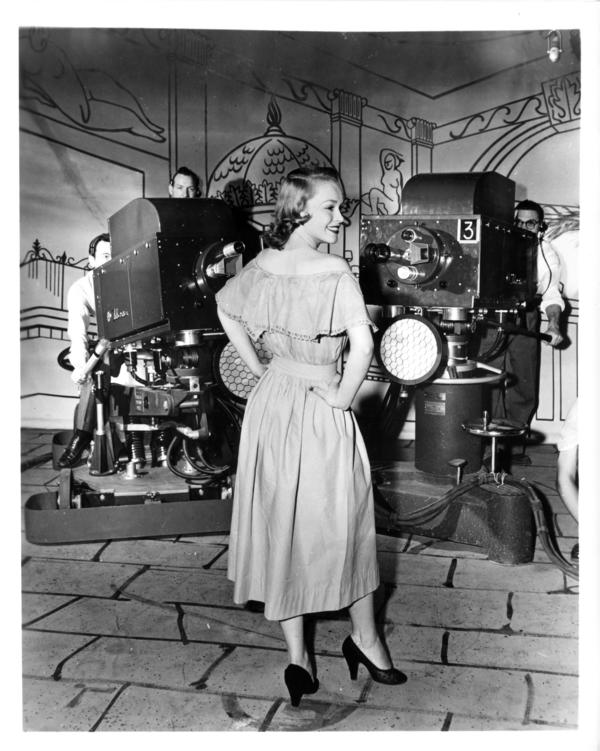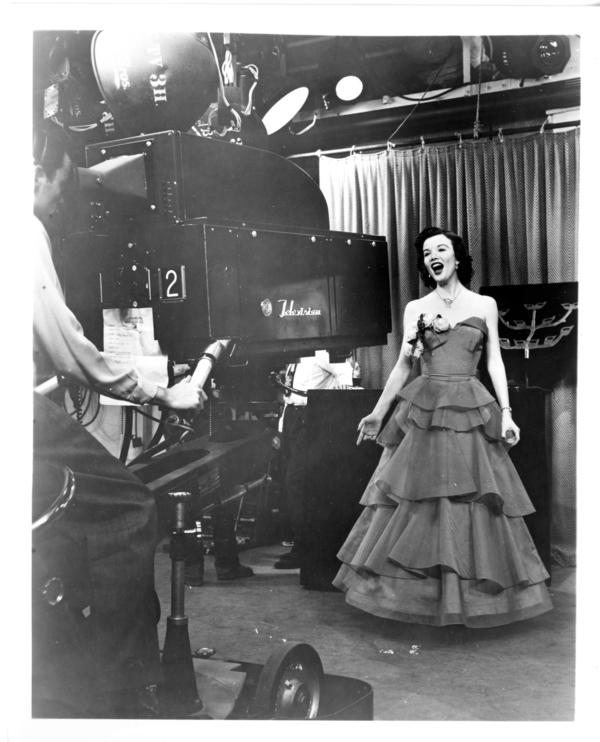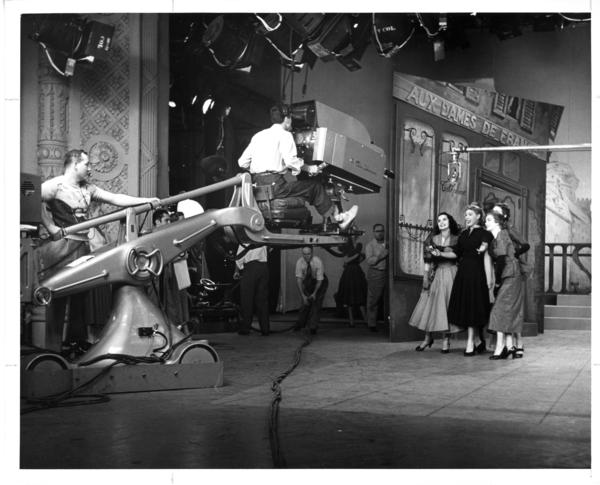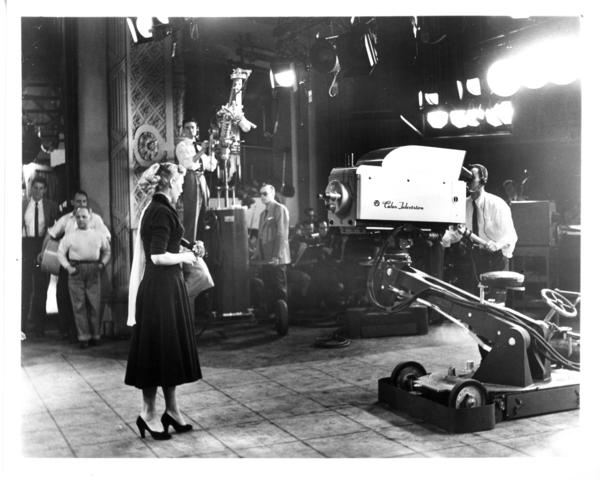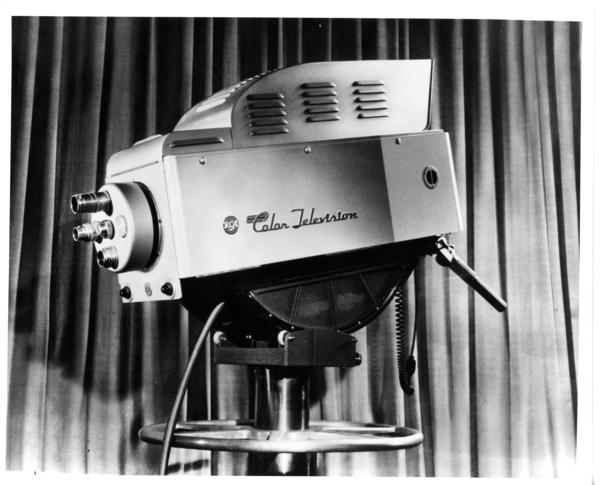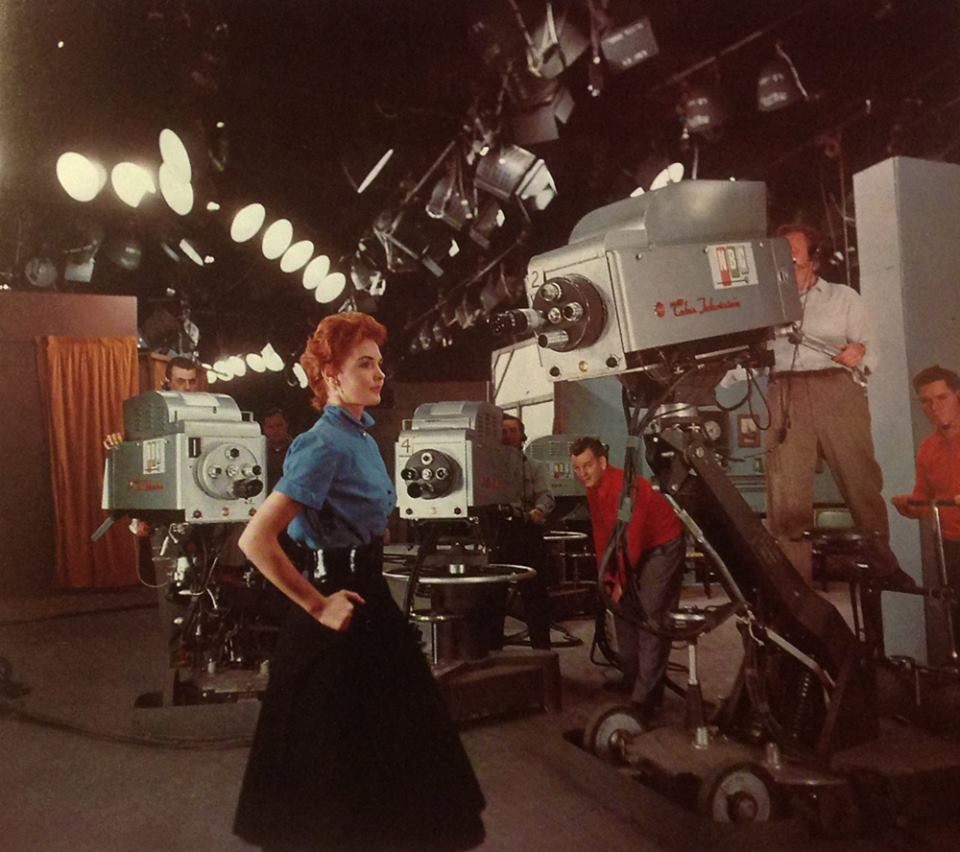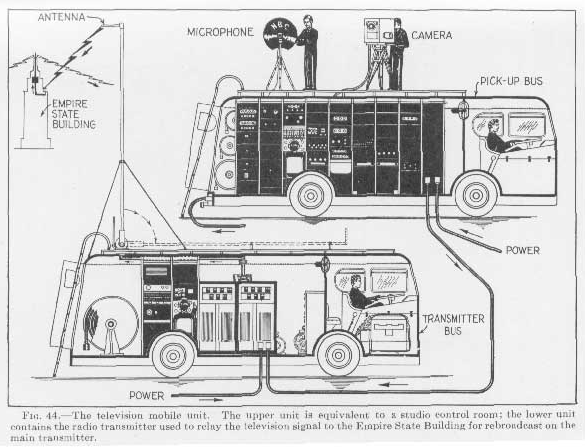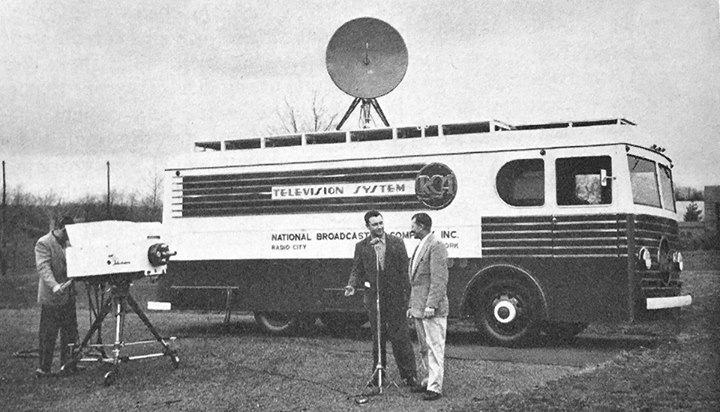“Battle Over Television” – Mechanix Illustrated, 1945
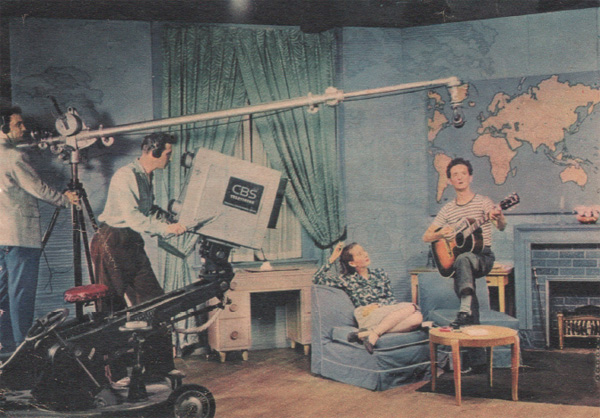
Thanks to Barry Mitchell, here’s some glimpses into how the future of television looked in January 1945. These excerpts from Mechanix Illustrated are interesting in several ways, not only for their photographic coverage of early television equipment and production techniques, and not only for their descriptions of early television equipment, but they are also a snapshot of the rivalry between RCA and CBS over different technical approaches to television.
The main article, by RCA spokesman Jack O’Brine, tells of RCA being “the recognized leader in television” and of the millions it has spent in the field. “Television has become an electronic art and practical possibility largely through the development in RCA laboratories of the Iconoscope and Kinescope,” O’Brine writes.
In a rebuttal, CBS vice-president J.H. Ream throws cold water on O’Brine’s claims and argues that RCA’s plans to jump in the postwar television market using prewar standards, “though understandable, is short-sighted” and will leave viewers unhappy. Ream advocates for using a higher-frequency band in the radio spectrum that would not only broadcast a 735-line picture (versus RCA’s 525-line system) but make color broadcasting easier.
We can also see the first shots of the “color war” in this piece. A picture of the experimental CBS color camera is featured, as well as a diagram of the mechanical color system. The caption notes that RCA has developed a special tube for electronic color broadcasting, and holds that “mechanical color systems are unsatisfactory.”
As a bonus, there’s an artist’s rendering, spread over two color pages, of what a television studio of the future could look like: a circular structure partitioned into four studios, with a turntable stage and a transmitting tower on top.
(One more item: Note on the final page the small piece about Mechanix Illustrated becoming the first science magazine to sponsor a television show when it presented a half-hour program from DuMont’s New York station. Check out as well the picture showing 1944’s idea of what the fashions of 1970 would look like.)
Thanks again to Barry Mitchell for this look into the state of the art from nearly eight decades ago. Enjoy!
THE TONIGHT SHOW WITH JACK PAAR Camera Cards
That I know of, these are the only two remaining camera cards from the wonderful era of THE TONIGHT SHOW WITH JACK PAAR. These were mounted on an easle in the studio and during the show, one of the RCA TK41 color cameras in NBC Studio 6B would shoot this full screen when the show went to, and returned from commercial breaks. Network spots rolled over this and often, there were only a couple of network spots in the break and then time for local spots, which would also play over this, BUT there were times when smaller market stations didn’t have spots sold, SO the locals would return to these cards and the audio of the band, which was led by Jack’s army buddy, pianist Jose Melis. The band would play under it until the end of the stop set and the show resumed. Next stop set, differnt card.
I am very pleased to have these in my collection and wish to thank Gary Morgan in New York, for donating these. Gary acquired both of these in 1964 while attending the RCA television school in New York City. Seems that one day, one of the NBC art department people came to guest lecture and brought these cards with him. By now, Johnny Carson was hosting so there was no more use for these little gems.
By the way, when Paar’s show became a smash hit, NBC renamed it “The Jack Paar Tonight Show”. When he moved to prime-time in 1962, NBC called his show “The Jack Paar Program” and as these say “show”, there may be some confusion as to which Paar program we are talking about. To clear things up, after 1959 (2 years into Paar’s Tonight Show hosting) the program became commonly reffered to as The Jack Paar Show, even at NBC.
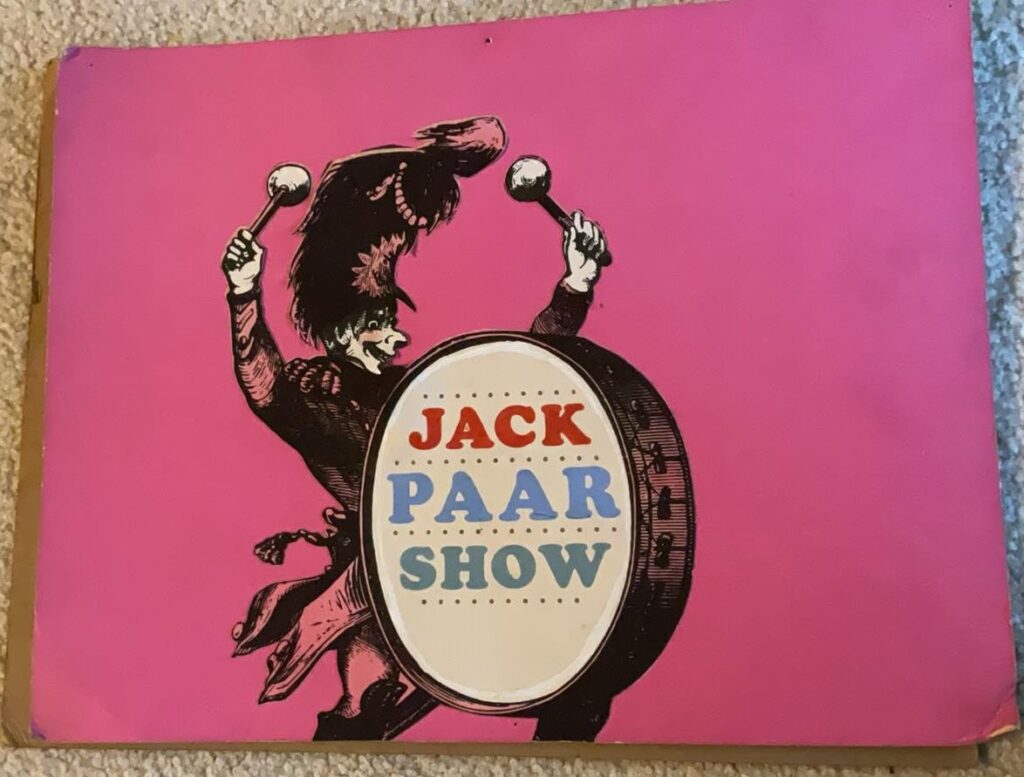
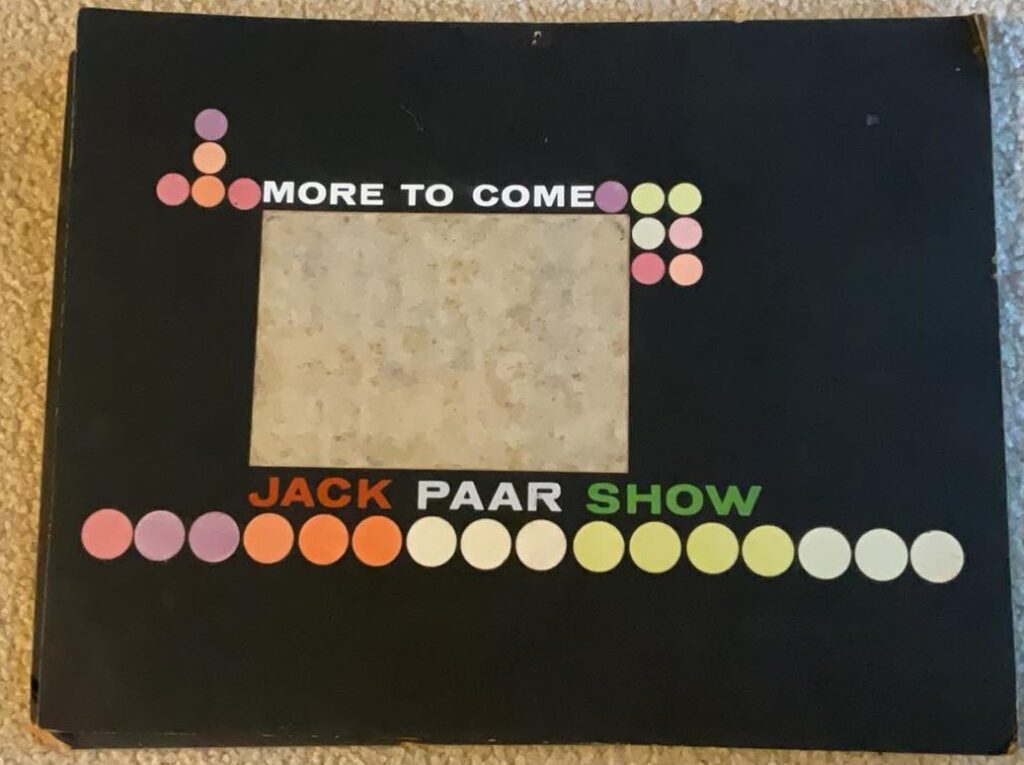
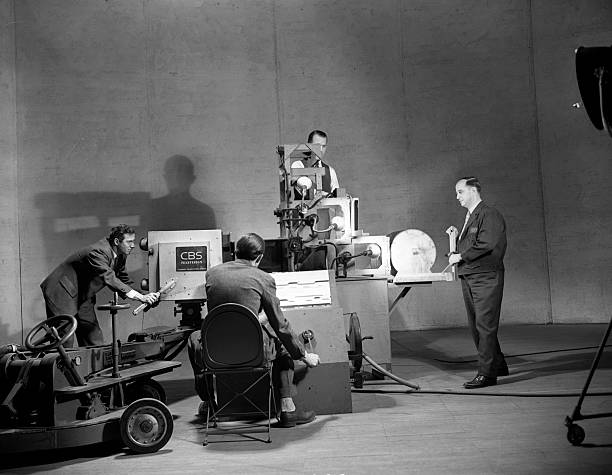
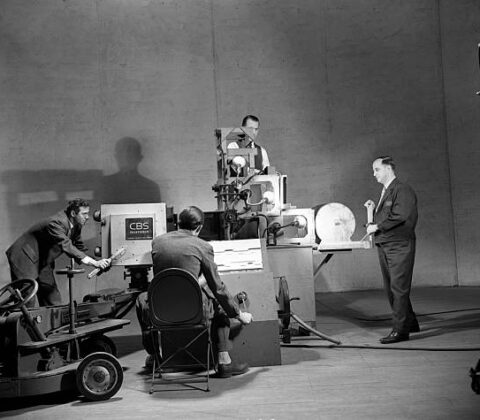
HOW TELEVISION GRAPHICS CAME TO BE
Not long ago, I came across some excelent historical images of television’s first experiments into shadow box technology and precursor elements to telecine and telop technology. I knew that the experts at The Museum of Broadcast Technology in Woonsocket, Rhode Island would be the key to explaining what we were seeing, so I asked our friends there to write this up. Tom Spraigue, Paul Beck, Jay Ballard and Pete Fasciani are MBT’s core and ALL have amazing backgrounds, and I have long been impressed by their work and mission. In this case, Paul Beck took the lead and brings to life how these great images show the transition from imagination to real world capability in an industry that had to be made up as you went along. THANKS to Paul and The Museum of Broadcast Technology for thier help. -Bobby Ellerbee
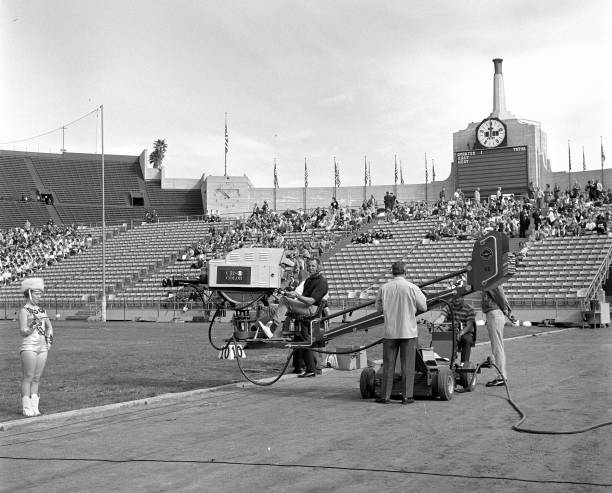
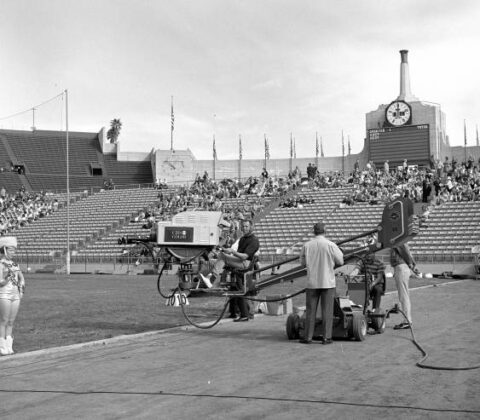
OH YES, THEY DID!!!
As your Editor In Chief of Eyes of A Generation, I pride myself on trying to display the best, most interesting images of our industry in action, but AT FIRST GLANCE, this series of pictures BLEW MY MIND! No one in their right mind would try to cover a football game with a Chapman Electra studio crane on the sidelines, EXCEPT – if there was a paved running track on the sidelines, which…there is here. In another rarity, CBS is using RCA TK41s (instead of Norelcos) to cover the event and odds are, they are using KTLA’s mobile units for this event. The same RCA built units that Red Skelton owned in the early ’60s. This is the 16th Annual NFL Pro Bowl at Los Angeles Memorial Coliesum in January of 1966. Enjoy! -Bobby Ellerbee



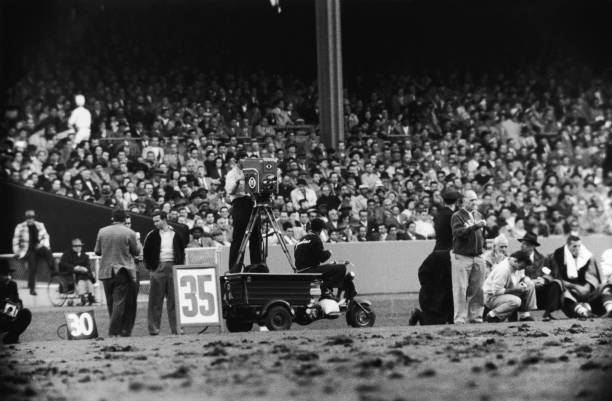
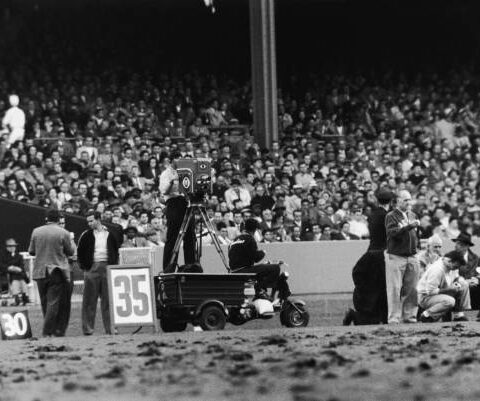
HOW NFL FOOTBALL CAME TO TELEVISION IN 1956
Sig Mickelson was the first president of CBS News, and it is from that insider’s view that we get this amazing story.
In only 8 pages, he explains how CBS public affairs management’s best laid plans to make Sunday afternoons their bull’s eye for public service programming got shot out of a cannon, and how pro football came to find its new home there. I have read Mr. Mickelson’s book, “The Decade That Shaped Television News – CBS in the 1950s” several times, but this time around, his writing on this major event really popped out, and I felt the best way to share this amazing story with you, is to present these 8 pages from his book for you to read for yourself.









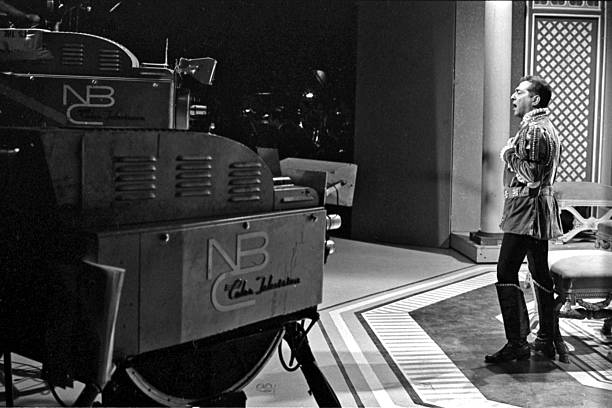
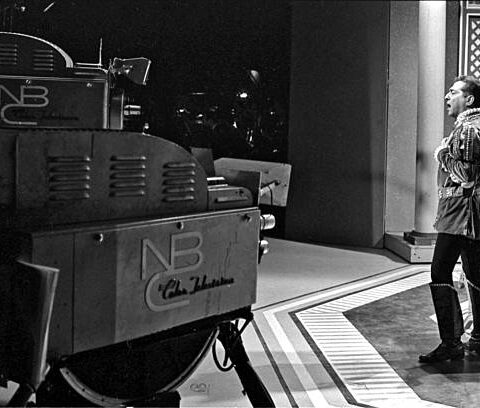
NBC COLOR PERFECT PROMOS FROM THE ’60S
Here, back to back, are two :60 second promo’s from NBC, touting their color abilities in the mid 1960s. You have to give them and RCA credit as the leaders in color. No one was better, but unfortunately, when these transfers were made from film to video a few years ago, the master prints had sufferd some major fading and these did not look at all “perfect”. Thanks to our NBC bretheren, we are able to verify that the director shown in the first promo is the great sports director Harry Coyle and the lighting director in the second promo is Bill Klages.
We’ve had some help from our friend Marc Wielage, who is a master Hollywood colorist, to help these look better. Marc says the 16mm print had turned magenta over time and there are basicly no greens or blues left, but with his careful touch, these rare gems do look much better than they did when we sent them to him. In addition to Marc’s help, many thanks to Mike Clark in Los Angeles for finding these in the first place.
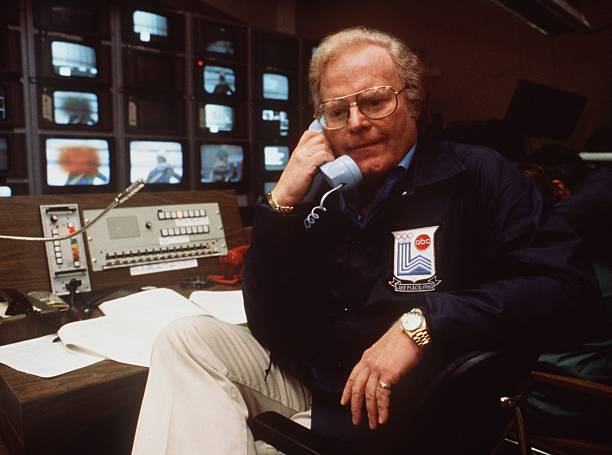
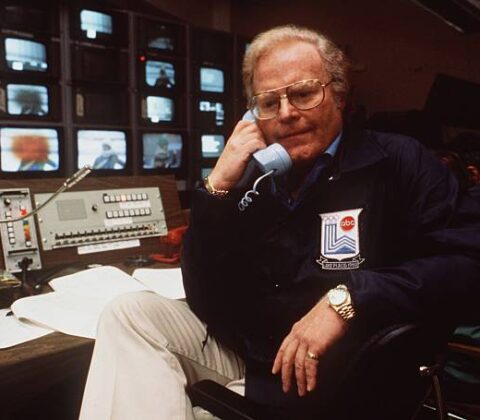
THE HOUSE THAT ROONE BUILT
Modern sports television began in Athens, Georgia on September 18, 1965 when the University of Georgia Bulldogs took on Alabama’s Crimson Tide at Sanford Stadium. The game, broadcast on ABC, was the first nationally televised game for Georgia, AND the start of Roone Arledge’s “Big Idea”. His famous 1960 memo to Ed Scherick, which laid out his ideas on how to “bring the viewer to the ballgame” is hard to find, but here it is…it starts with the indented part of this first page and finishes at the top of the third page.
After that is the description of how Roone put it into practice in Athens that crisp fall afternoon when he took the helm in the truck and produced that season’s first game. Going forward, all the ABC producers were were busy incorporating these new measures into their game presentations.




Luck was with Roone and The Bulldogs that day, because at the very last minute, Georgia coach Vince Dooley called a trick play and won the game with an 18 to 17 victory over Bear Bryant. Here is that now famous 22-second play. Many thanks to author Marc Gunther for his great 1994 book “The House That Roone Built: The Inside Story of ABC News”. It is a great behind-the-scenes account of how Roone Arledge transformed ABC’s sports, and later their news division and draws on interviews with top network personnel to examine Arledge’s willingness to experiment and to spend money on talent.
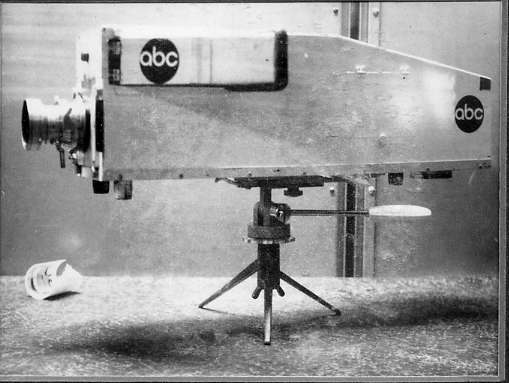

The Surprising History of ABC’s First Handheld Cameras…LA vs. NYC
About six months ago, I met a character named Joe Maltz somehow. Turns out that in 1961, Joe was the Supervisor of Engineering Maintenance for ABC in New York and had a GREAT STORY to tell! In a nutshell, Joe was put in charge of developing a handheld camera that was better than the one the engineers at ABC Prospect in Los Angeles had just developed.
To set the stage and I need to add some history for perspective, broadcast history and ABC west coast and east coast history. First, the broadcast history; in 1950, NBC had built the first handheld camera, two years before RCA introduced their version (1952) and both were Vidicon cameras. By 1956, RCA had developed a wireless version of the camera and they were used at the political conventions that year and had once been used on the sidelines at a football game in New York state, but only that one time for some reason. FYI, CBS engineering head Dr Dan Flaherty was working with Ikegami on a handheld camera too and the first known used of it was in February of 1962 during the Mercury flights at NASA.
On the ABC Los Angeles history side: Roone Arledge had just been hired (1960) and his job was to get ABC more deeply involved in sports broadcasting, and HE DID! Inside the company, managers began trying to forecast what kind of new technology would be needed and at ABC Prospect in Los Angeles, an engineer named Don McCroskey had an idea. He wanted to build a handheld camera using a full-size Image Orthicon tube. As luck would have it, he had two retired GE PC 7 Image Orthicon cameras on the lot, and they were the sacrificial lambs that would supply the parts for two portable cameras. Aiding Don were engineers Dean Cannon, Bob Bleiwiess and Jerry Buchi who helped refine the camera.
Below is Jim Angel behind one of the GE cameras testing the tubes before they were wheeled into the Prospect lot’s engineering garage for surgery…they were having their yokes “transplanted”.

Below is ABC’s first handheld cameraman Mike Friedman, one of their TOP operators for years before this photo was made of him shooting Jim McKay for WIDE WORLD OF SPORTS. Mike went on to directing on WIDE WORLD.

Below is ABC’S first portable camera “demonstrated” by our great friend DON “PEACHES” LANGFORD, who, as a firsthand witness to this history, also contributed to this article. Oh, and the bald wig Don is wearing is a tribute to his boss, Mike Friedman, who sported the look many years before it was a “thing.”

Below is a 2016 photo of Don Langford with the camera he used in the mid 1960s at ABC, the one you see him with in the photo above. When the two cameras were retired in the 70s, ABC LA manager Robert Trachinger made sure they were not lost to history and these two are still in his care.

Below is one final photo of the Los Angeles version in use in 1963 at The University of Virgina.

NOW TO THE EAST COAST ABC HISTORY AND THE “ABC PRESS ORTH CAMERA” DEVELOPMENT. Below is a photo of that rarity.

When Joe Maltz began to tell me about this, he kept mentioning the “press orth” and I had no idea what he was talking about, so I finally asked him what a press orth was. To my surprise he said that was the name of the camera! TWO EVEN BIGGER SURPRISES came when I was on the phone with Don “Peaches” Langford in LA fact checking this article. 1st, When I told him about the press orth name, he said “Yeah, that’s what we called ours too, but we were first, and New York just added the city name to the Press Orth name.” 2nd, their first press orth in LA was cabled directly the carcass of one of the GE cameras, minus the viewfinder! That must have been an odd sight. There was 50 feet of cable between the new camera head (basically the GE’s yoke assembly) and the old camera head with 50 more feet of cable to the truck. On their second version, they managed a better workaround. Oh, and Peaches did know Joe Maltz as he had covered many events in NYC too. I love to be amazed!
Here is part of the story Joe Maltz told me:
The engineers at ABC’s Los Angeles operation had, in order to give the cameraman more maneuverability, created a small hand-held camera by separating the television pickup tube assembly from the bowels of a GE television camera, extended the cable harness, added an optical viewfinder and created what I believe was ABC’s first broadcast hand “hand-held” camera. The “Creepy-Peepie”, as it was dubbed, was tethered to the carcass of the camera by the cable harness.
There were two problems. The concept was great, but the quality left much to be desired. The second problem was, considering the rivalry between the ABC East Coast and West Coast operations, the “Creepy-Peepy” was an NIH (Not Invented Here) creation. The New York Operations Group was jealous. This situation had to be rectified.
During this period, I was the Supervisor of Engineering Maintenance in New York. I had the reputation of being an innovator. Merle Worster, the Director of Technical Operations for the East Coast, asked me if I could come up with New York alternative for the Creepy Peepy. I agreed and did some research as to what would be required for a suitable hand-held camera. The unit had to have the following features:
- Light enough to be easily carried and operated by a single cameraman.
- The camera cable had to be extended to at least 200 feet and had to be able to operate with a 200-foot cable
- An electronic viewfinder would be required.
- The operating controls had to be easily accessible.
- The electronics would have to be compatible with the existing Camera Control Units.
After six weeks of design and construction, with the help of Harold Gordon and Bill Wagner, the camera, with all of the above features was used for the first time on an ABC Wide World of Sports television program. I dubbed the camera, the “New York Press Orth”.
I designed the NY version and Harrold Gordon built it. The electronic viewfinder was created from CRT tube from Philco Safari portable TV with tube facing front of camera with 2 bending mirrors for the eyepiece. Interior of both (2 units built in NYC) cameras were made of TK31 parts as many were smaller than the TK30 components. – Joe Maltz
Below are pictures Mr Maltz sent that show some of the features of the camera and showing it in action…this first image is at the Liston–Clay fight (Ali had not yet changed his name from Cassius Clay), on February 25, 1964 in Miami Beach, Florida.
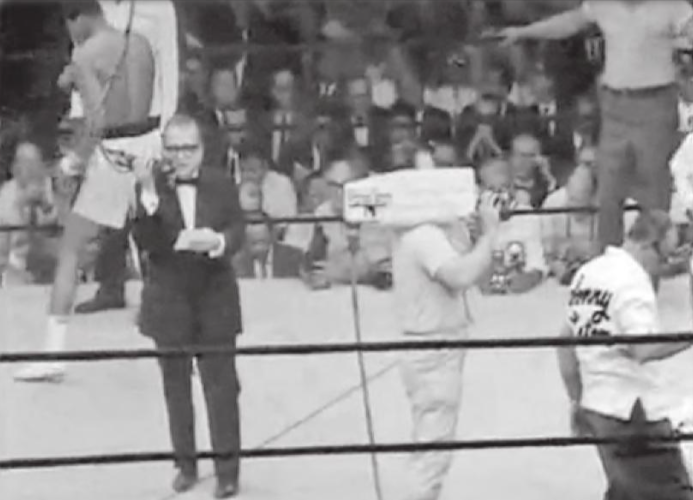
Here is the shoulder harness that became a real necessity as soon as the camera was tested.

And finally, this is the auxiliary unit for the ABC Press Orth camera.
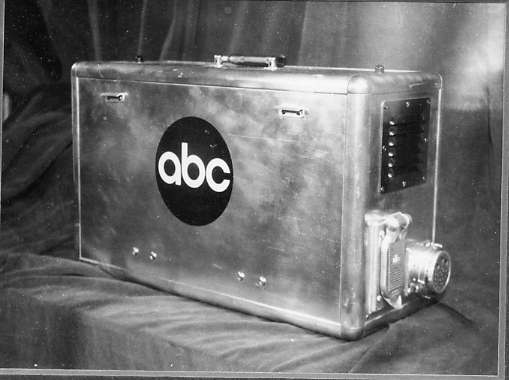
Below is one of the NYC Press Orths in use at the 1964 Olympics in Innsbruck
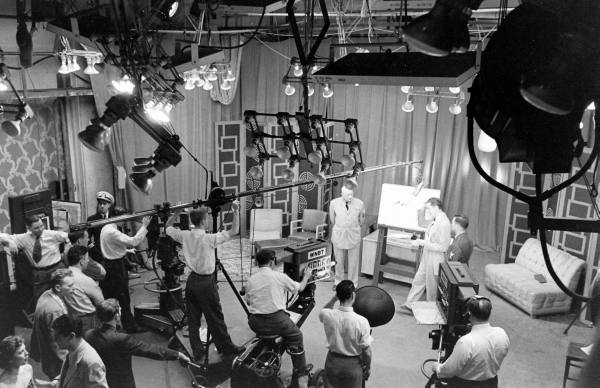
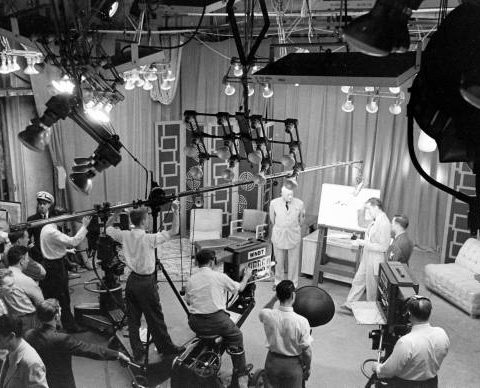
Ultra Rare…Inside NBC’s New York Studios 1950
As TV was taking off in 1950, NBC and others struggled to find studio space in New York. This rare film shows us, in more detail than we have ever seen, the course those efforts with a look inside not only the “Radio City” 30 Rock building, but also the International, Center and Hudson Theaters and thankfully, the “missing link” is shown here too…NBC’s Uptown Studios at 106th Street. There is a lot more here, including film of the NBC Kinescope department, the renovation of Studio 8H for TV, a new Master Control and much more. This film has been out of sight for decades but has now resurfaced, complete with narration by NBC’s first television news anchorman John Cameron Swayze.
A huge thanks to TV historian Alec Cumming and Ken Aymong at SNL for locating and preserving this fabulous NBC Studio history archive! -Bobby Ellerbee
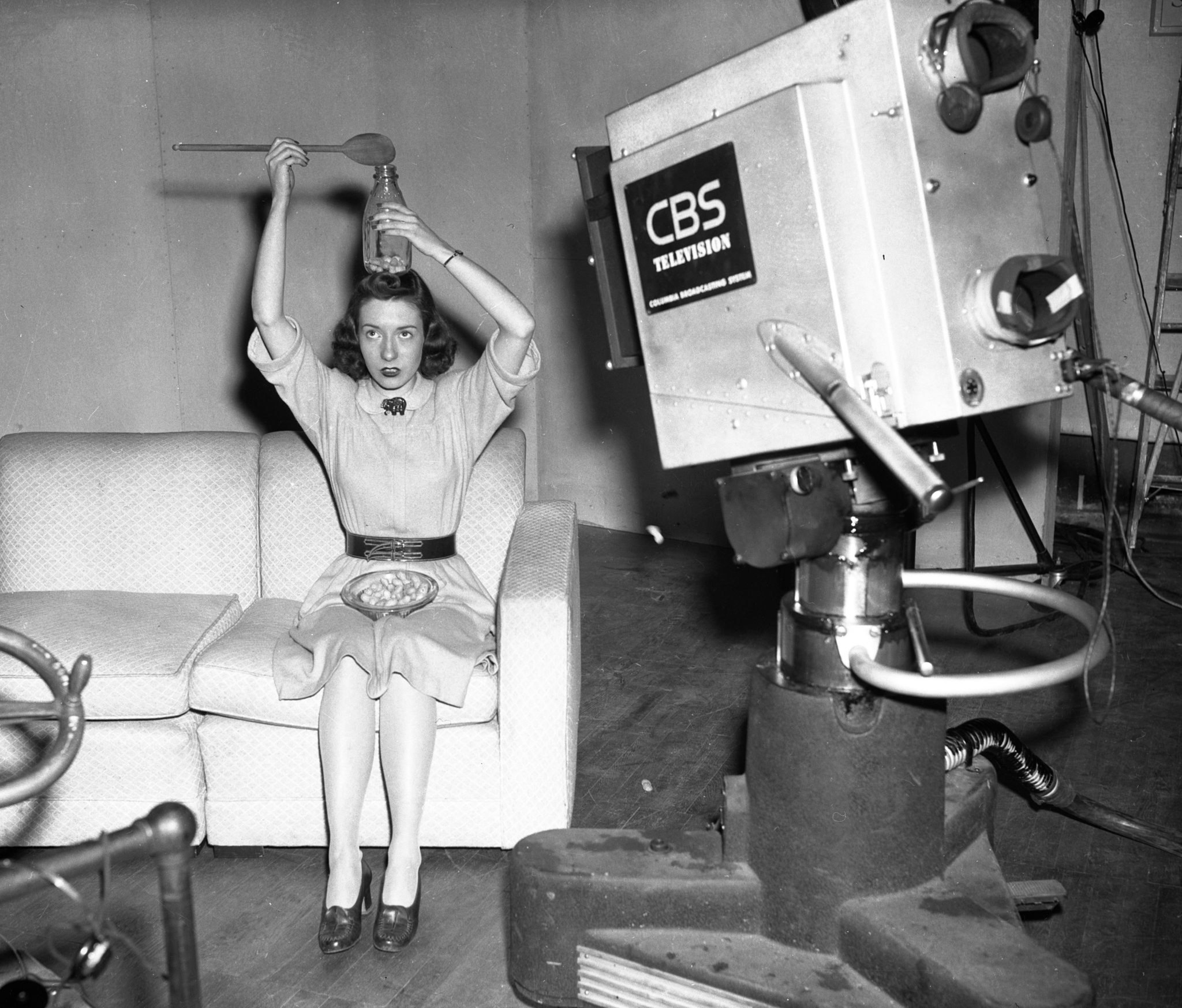
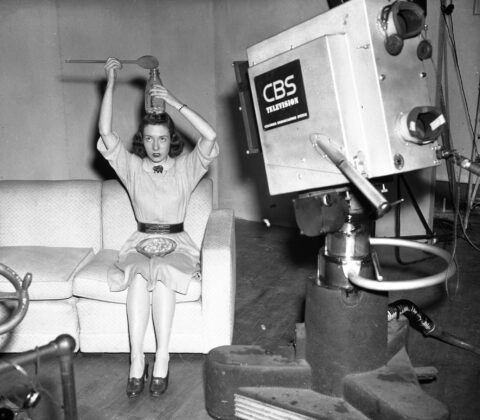
MEET TELEVISION’S FIRST FEMALE DIRECTOR! FRANCIS BUSS BUCH

RCA’S FIRST ICONOSCOPE CAMERAS & THE PROTOTYPE
We will see three different Iconoscope cameras here…the first three all electronic cameras made by RCA at their Camden N.J. labs. These images are from the David Sarnoff Library Collection and are quite rare these days.
The first we’ll see will be the prototype camera developed by Dr. Zworykin around 1932. The second is a more sophisticated model that RCA introduced in 1934 and the last camera is the “icon” of early cameras, the one some refer to as the A500, which was first used in RCA/NBC experimental Studio 3H at Rockefeller Plaza. I would like to suggest that from here on out, we all refer to those hard-bodied cameras as the Studio 3H Iconoscope cameras.
RCA ICONOSCOPE PROTOTYPE CAMERA
If you look closely at the bottom of the camera, notice the rubber feet…items that suggest this sits on ‘something’ and we’ll see that something a few images down.
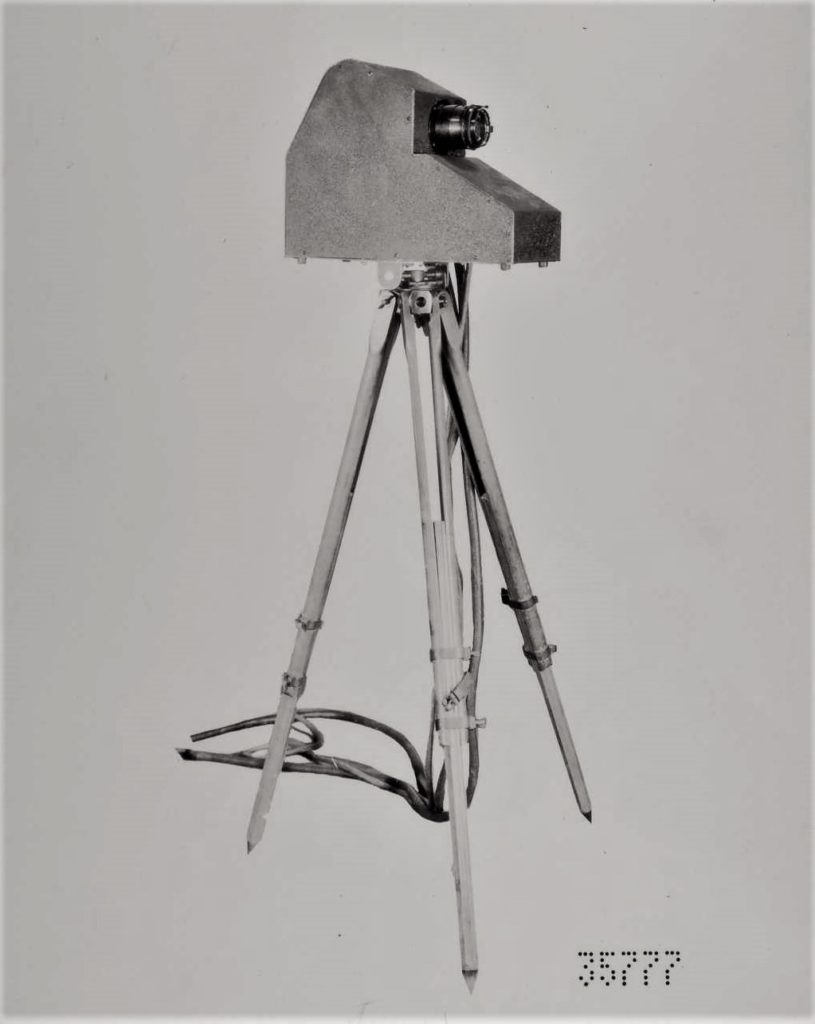
Below is the first ever shot of an electronic RCA TV camera with it’s camera control unit
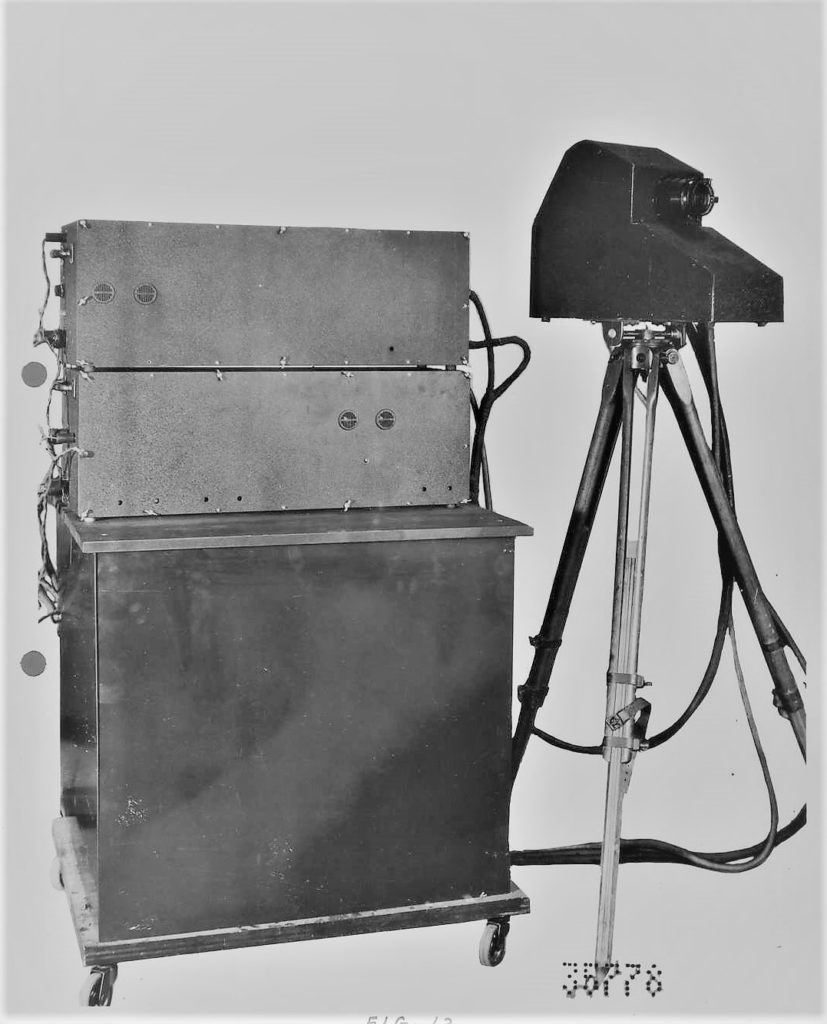
Below is the paragraph from the RCA Broadcast News article (you’ll soon see) which describes the camera and configuration above, which is the original image that was photographed for the magazine article by Dr. Zworykin.
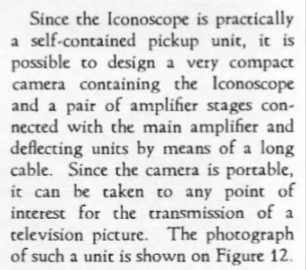
Here is the ‘something’ the camera sits on and the camera we see above is on the left. The unit it is sitting on is basically ‘the control room’ with all the components neatly packed together on this convenient rolling rack, so it is also a ‘remote unit’ of sorts since they can take it from lab to lab to experiment. Up top, in front of the camera there seems to be an experiment in progress as the prototype is shooting into a microscope with a light source shooting from the other side of the microscope’s slide table. Although this is an electronic system, it seems to have rotating mechanical disc at the light source, used for generating synchronizing pulses. As electronics progressed, less and less mechanical means were necessary to get a good stable image. It would be interesting to see the result of this experiment, which is possibly being conducted to see if there is a medical use for the new apparatus.
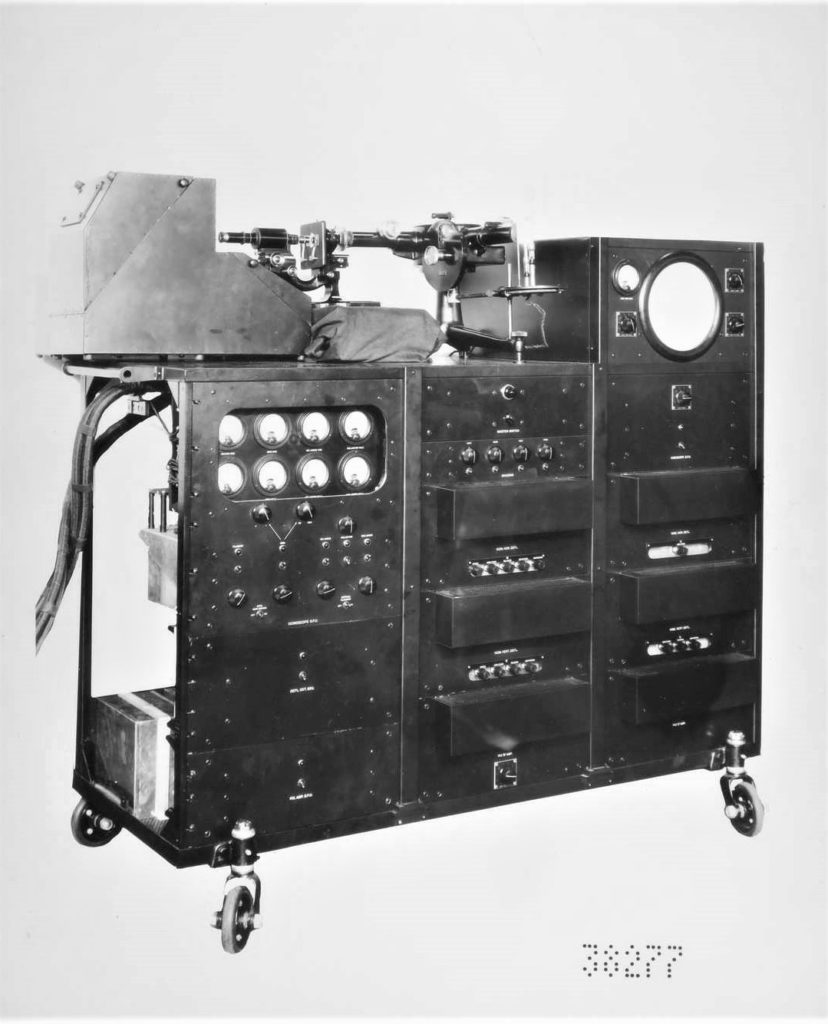
Before we move to the second camera, here is the August 1933 edition of the RCA Broadcast News magazine I mentioned with an 8 page paper on the new Iconoscope Tube by Dr. Vladimir Zworykin, the tube’s inventor. On pages 6 – 14 he describes the technology in detail and the image of the camera above is shown here on page 13 with it’s description on page 12.
THE FIRST RCA ICONOSCOPE CAMERA
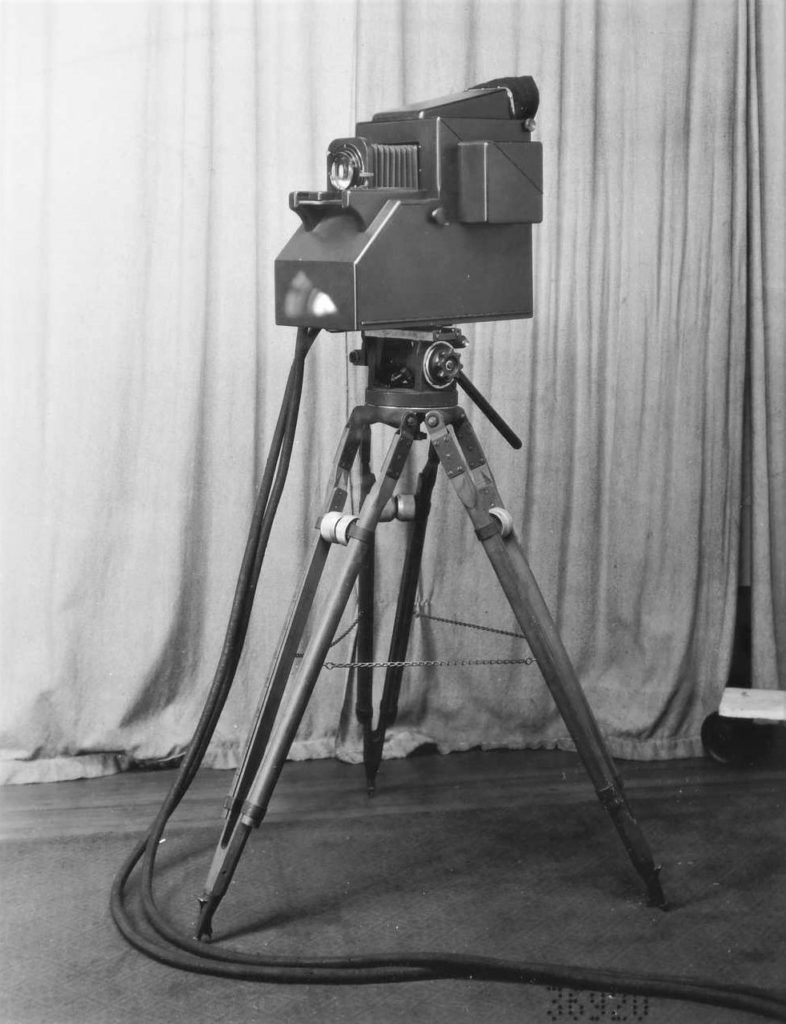
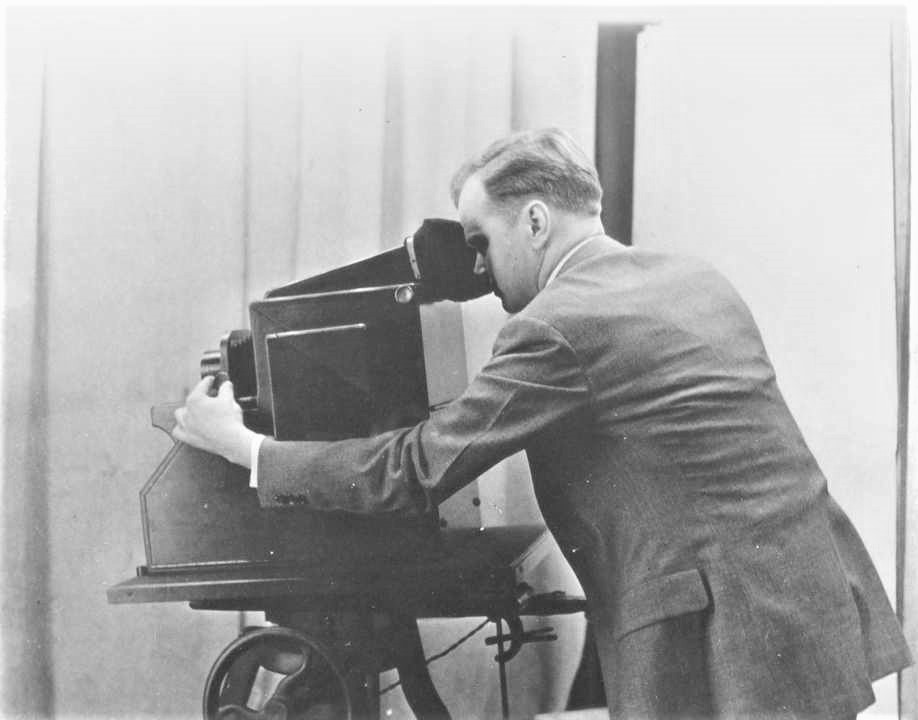
Above are two shots of the camera in testing at RCA’s Camden N.J. labs. Notice there is viewfinder on this model very similar to the kind you find on photographic cameras which is an optical viewfinder made of ground glass which captures the image from the lens.

![]()
Above left we see the interior in a nice clear shot and on the right a helpful labeling of the parts. We know the date of this camera because of the date on this photo from Dr. Zworykin’s photo albums that he kept at work to record events. This is RCA’s Lesley Florey in early tests to the camera in 1934 at Camden, but we think this was in use in 1933 too. Notice the tube is bubble shaped, but as resolution increased the tube became more drum like.
![]()
Below is a 1937 article that shows this same camera at Philadelphia experimental station W3XE which was owned by Philco. Philo Farnsworth was there in the mid 1930s, but competition was fierce and trade secrets were held close to the vest. Some former RCA engineers had come to work there in the early 1930s when RCA refused to sell any of their iconoscope tubes, and they began making their own tubes.
When RCA set up their experimental Studio 3H at Radio City in the spring of 1935, they had an all new camera design (which we’ll see next) and once 3H had been in operation for a while, Philco convinced RCA to sell them their bellows lens cameras (of which I believe there were two) to use in their W3XE station. Below is an article from 1937 that shows the RCA camera in use there. I included this image and info to help with any confusion with seeing the same camera at two different places.

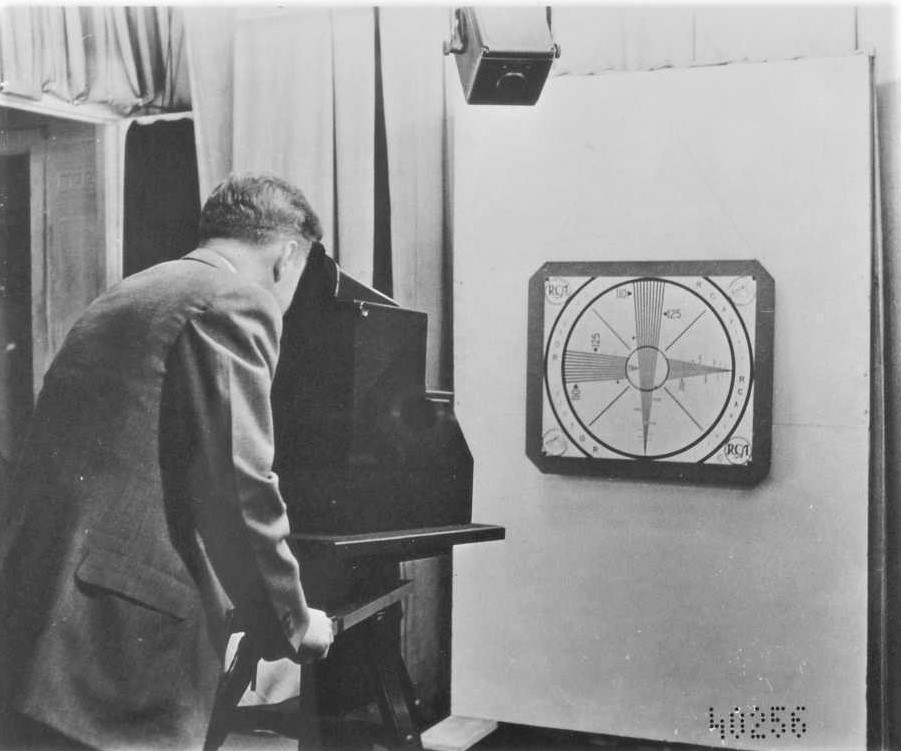
Above we see the camera shooting a test pattern in Camden and below, a transmitted image of this pattern in 1933.
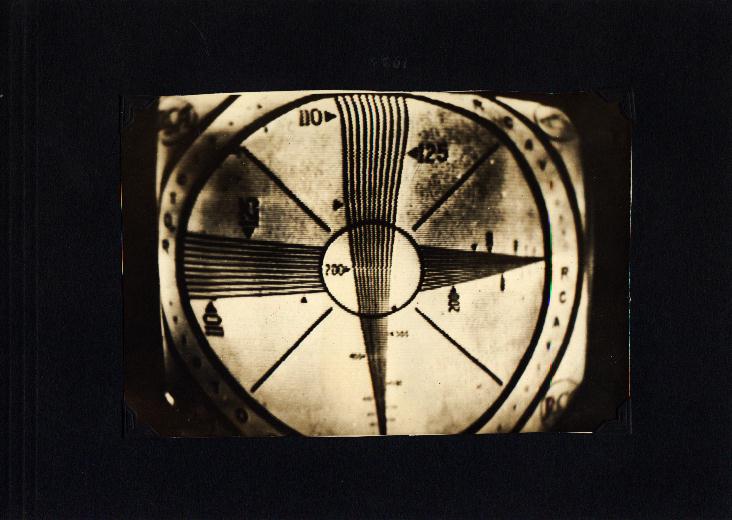
THE 1935 RCA STUDIO 3H ICONOSCOPE CAMERA
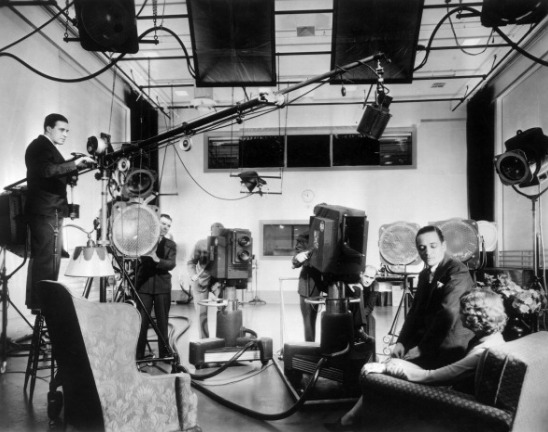
Above, the very first all electronic television studio…RCA Studio 3H at NBC’s 30 Rockefeller Plaza. In 1937, RCA transferred control of the studio to NBC Television, but until the mid 50s, there was usually some kind of testing going on in this space, along with programs originating here like Howdy Doody. As a matter of fact, when Howdy started December 27, 1947 the show was shot with these very cameras. Only after Studio 8G opened in June of ’48 did Studio 3H get three new RCA TK30 Image Orthicon cameras.
There were three of these hard bodied camera in Studio 3H and most of the time, at least one of the cameras was mounted on a Panoram dolly. In-fact the one shown here in the second image down may be a prototype as it has a nice wooden footrest/step up for the cameraman, the wheel base is longer and the rotating section is more centered in the chassis than the versions we see in the late ’40s and ’50s.
NOTICE AS WE GO! This is a “dating” trick of mine that gives me an idea when photos were taken. NOTICE on the photos above, there is a round RCA decal and below it is a square NBC decal, which are the original markings of these cameras. When you see that you know the photo was from about 1935 till 1937. After ’37, the round NBC decal was there and many times the second (or low viewfinder port) is sealed as in the image below.
Keep in mind, the camera bodies are the same three that were built in 1935…even the silver versions. All that changed was the internal workings and especially the Iconoscope tube’s resolution. These cameras started with 345 lines of resolution with their original dressing, then when they went to 441 lines, the camera art changed to the round NBC logo and the bottom viewfinder port was sealed. The silver on these cameras at NBC (and the ones they sold to CBS) occurred when the 525 line tubes came along on July 1, 1941.

The next image shows you the removeable lens plates that snap on and off for quick changes in the studio when a close up or wide shot is needed.
![]()
Here is the interior of the camera that shows you just how the optical (ground glass) viewfinder worked and where the tube was.
![]()
One of the big drawbacks to the optical viewfinder was the impossible upside down and backward image the cameraman had to deal with. To him, the voice command of left, meant right and up meant down!
![]()
In this image below, notice the 345 line Iconoscope tube is very bubble like which marks this as the original tube style in these cameras. If you are confused, these opened from the back and tilted up to get to the interior components.
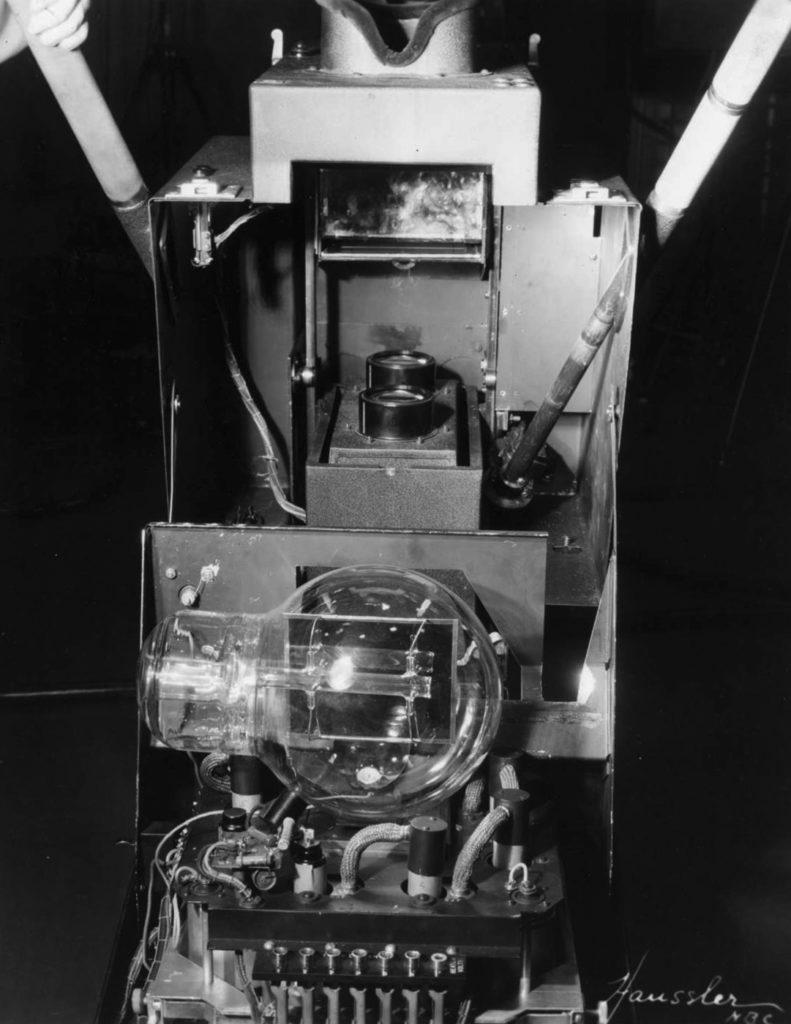
Notice in the image below, the bottom viewfinder port is gone and the Iconoscope tube is now the very familiar drum shaped tube we think of as the “normal” shape for these instruments. This image may be from around 1939 and shows a 441 line resolution setup.
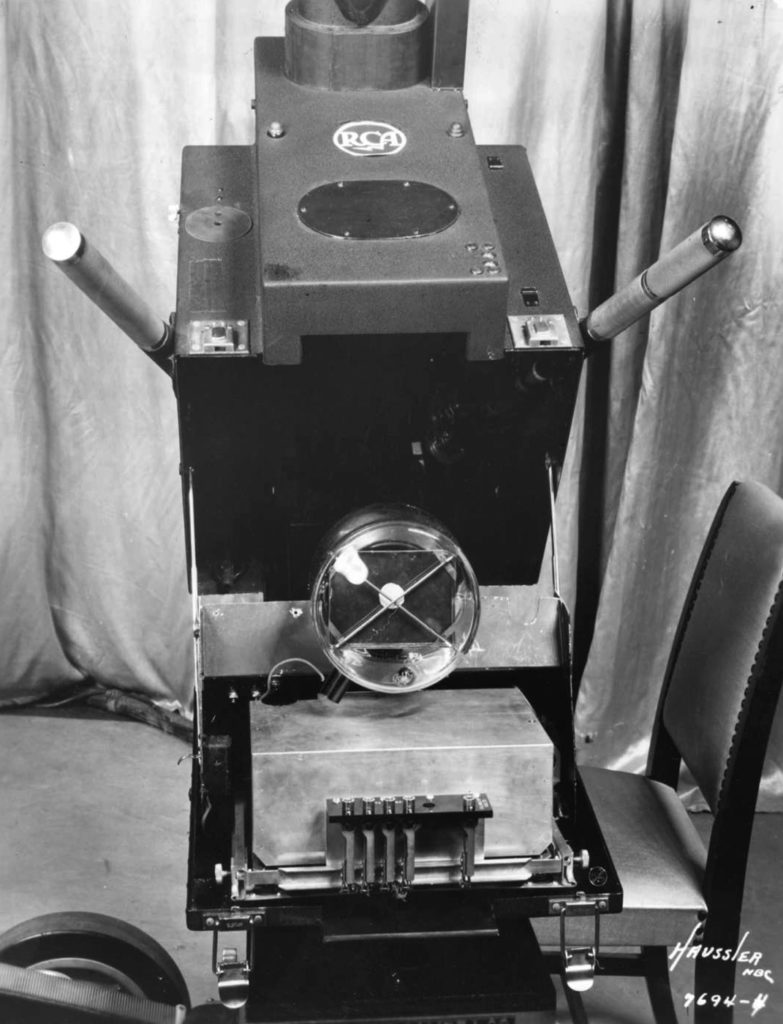
If you thought Felix The Cat camera models went out with mechanical television, think again! Here is a photo shot off the monitor in Studio 3H on February 5, 1937 showing how he looked with the new 441 lines of resolution.
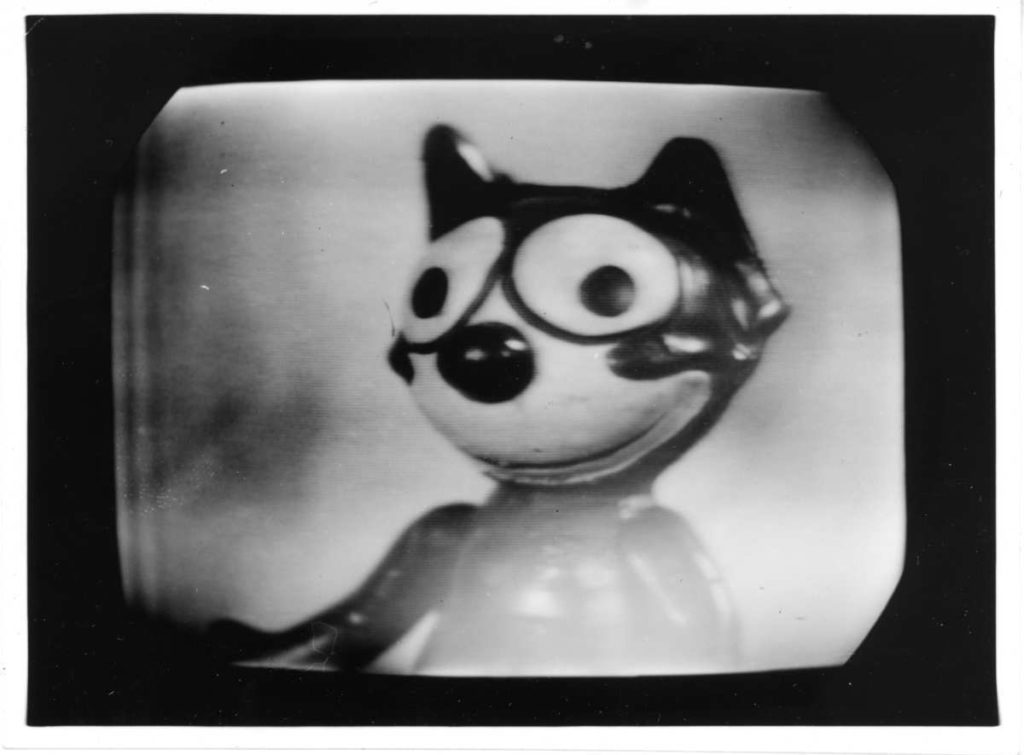
Below, the final step as the camera bodies are painted silver to denote the upgrade in resolution to 525 lines of resolution and this is a good look at the 1850A style six inch iconoscope tube.
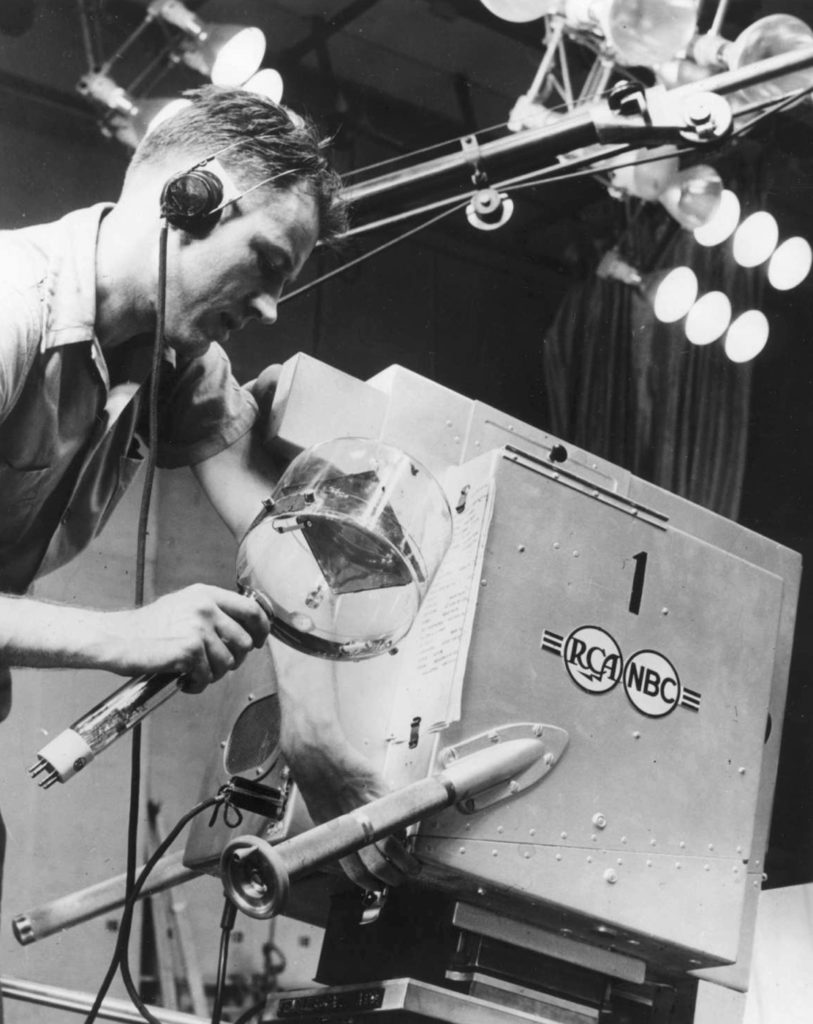
Here are our last images which show up top, a 1941 “Miss Legs” contest and below, an early necessity in Studio 3H…Miss Patience, a mannequin that acts as a stand in under the blistering light needed for the iconoscope.
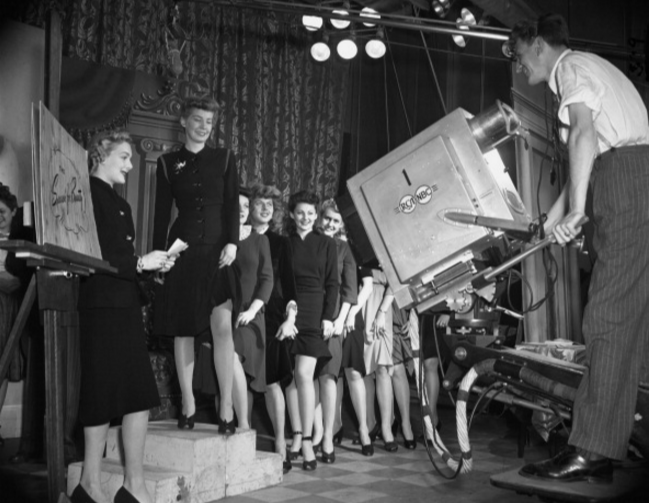

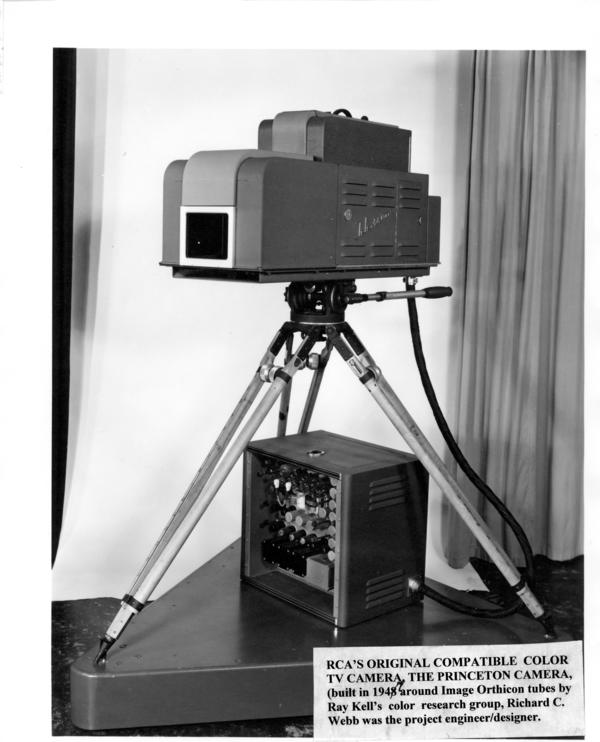
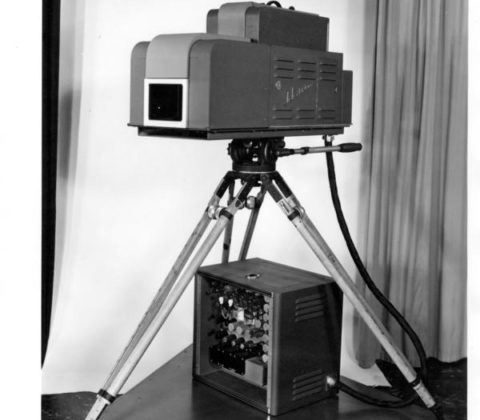
A PRIMER ON RCA’S EARLIEST COMPATABLE COLOR CAMERAS
I’ve just recently been able see these stunning in-house marketing photos that reveal some news about the first three sets of RCA’s compatible color prototype cameras. We now know the “name” of the first set of color compatible prototype cameras.
These are the Princeton Cameras. There were two of these and after being built in Princeton NJ at RCA Labs, they were sent to NBC’s Wardman Park Hotel studios in Washington DC where they were put through their paces for the FCC, members of congress and of course the engineers in Princeton that saw everything on a closed circuit feed, while still developing support equipment. The other two camera types we’ll see here are the three Coffin Cameras and the four TK40 Prototype cameras.
If you look closely at the date in the photo label at the bottom right (top photo) notice that the photo is dated 1948, but the 8 is struck through to give us a date of 1947! Also, notice “additions” as we go and note that these first few images are most likely the first pictures as there are not any exhaust fans on top yet, AND…notice the big boxes that each camera is connected to. Chuck Pharis and I have come to the conclusion that these are what he calls an, “intermediate or auxiliary box”, which is just a place for components which were as of yet, unable to be included inside the camera head. As we go, you will see that at first there is a single cable from the camera to the box, but later these Princeton Cameras will have 3 cables to the box. The early DuMont cameras had these aux boxes too.
Below is Dr. Richard C Webb with his invention with the cowling off so we can see the optical system which uses what look like three 90mm lenses behind the dichroic mirrors. The preamps are on top, but notice the intermediate box underneath. You may have seen this image before, but this is the original uncropped image as you notice the crop marks for the smaller images.
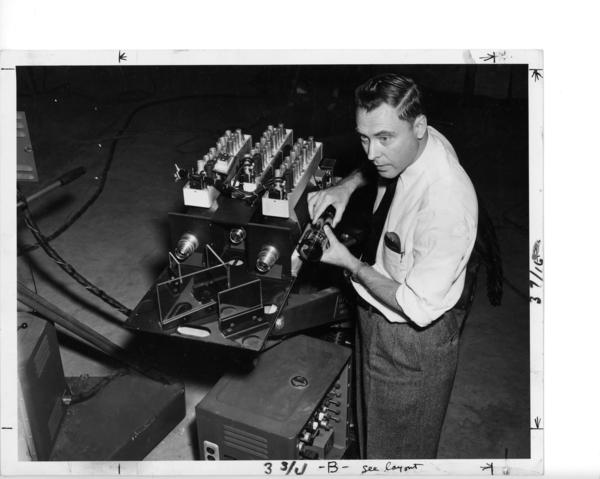
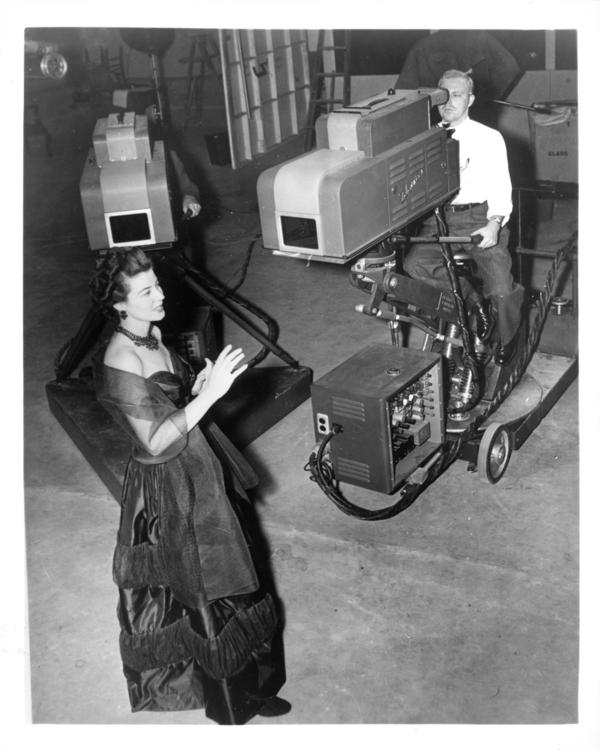
The image below shows a bit of the inside with the rear door removed BUT, in the two images below, notice the cameraman seems to be gripping a rod (like a Zoomar rod) which now answers the question of just how focus was handled on this early model, which still depends on moving the camera in and out to achieve close ups as there is yet a zoom or turret lens system.
In the final two images (above) of the Princeton Cameras we see the final refinement that shows us a newly configured optical system box which is now in a separate enclosure with a cowl cover of it’s own. FYI, the smaller camera is the experimental Tri Color camera. Oh…and if you thought the viewfinder looked familiar, it is the same one RCA used for the TK10 and TK30 models.
The Three RCA Coffin Cameras were the immediate successors to the Princeton Cameras and were also built in Princeton. When the Princeton Cameras were retired, they went back to RCA Labs there where they were bench tested a lot but compatible color trials had moved onward and “upward”…from NBC’s Wardman Park studio to Studio 3H at 30 Rockefeller Plaza. These black cameras were said to be big enough to be buried in so their nick name caught on…the Coffin Cameras.
Notice these cameras have the new turret mounted lenses and a side focus just like their black and white brothers, the TK10 and TK30. In the middle image is NBC Color Girl Marie McNamara in Studio 3H and at the bottom, is Nanette Fabre performing in the daily close circuit show that was shown to the engineers at 30 Rock, Princeton and in the RCA Exhibit Hall just across from NBC on 49th Street. These were in use for testing from about 1949 till 1952.
RCA TK40 PROTOTYPES
There were four of these cameras made and were used only at NBC’s first color studio at The Colonial Theater in New York which began testing in 1952. The hand of RCA’s top industrial designer John Vasos is evident in the now smooth lines of this classic look.
NBC’s 1938 vintage mobile units were retrofitted for color when Coffin Cameras were still in use and broadcast live from Palisades Park for one of the first color remote tests. One on the Colonial’s TK40 prototypes was also occasionally kidnapped for color field tests, and in 1954 when the Rose Parade was broadcast in color from Los Angeles, the new NBC Color Unit stopped by The Colonial to “borrow” all the cameras for a week.
The top two images show the TK40 prototypes with no vents on the viewfinder hood and that was the way ALL TK40s were made…all 28 of them, until the TK41 debuted in 1954. All except for one of the Colonial’s TK40s were retrofitted with vented VF covers as is seen in the final photo. Also, in that color image, notice the turrets on the two cameras on the right…those are salvaged from their Coffin Camera predecessors. I’ll bet the turret on Camera 3 (in the background) is glossy black too. -Bobby Ellerbee
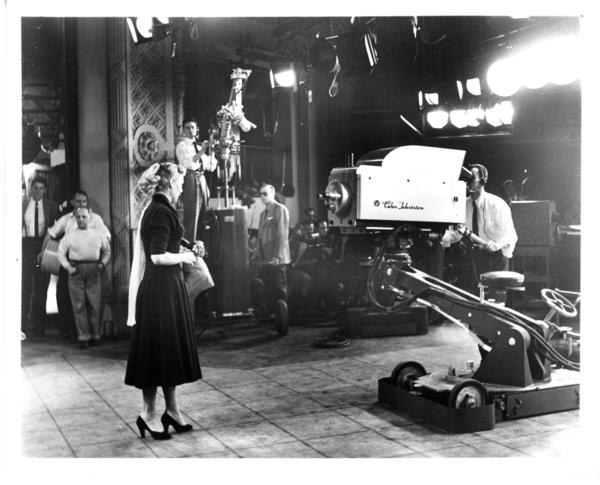
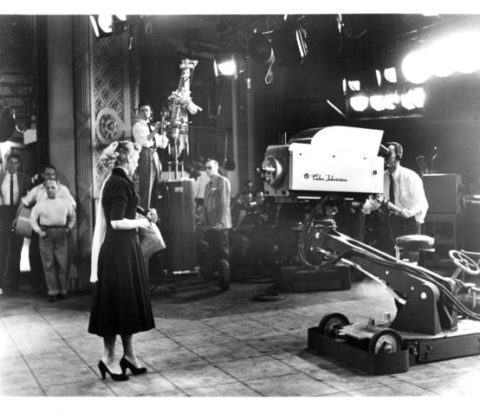
INSIDE NBC’S COLONIAL THEATER & RCA’S COLOR EFFORT
In all these 15 years of research, I have never found this whole black and white promotional film from RCA until just yesterday! This amazing film titled “Color Television; an NBC Documentary” shows some of the most advanced science of the day as we are taken behind the scenes not only at The Colonial Theater which was the very first color studio, but to RCA’s laboratories and factories in Princeton and Camden NJ and more.
There are many places to stop and ogle here, but I’ll point out a few highpoints for me, as they show us the prototype RCA TK40s AND the prototype of the first color camera (14:38) and the experimental Tri Color camera (19:11).
We get our first look inside The Colonial at 3:45 and our host is NBC’s Chairman, Pat Weaver. At 6:45 we see a novice actress who’s starred in NBC’s closed circuit color daily test broadcasts for two years, but by 1949 will have a TONY Award…Nanette Fabray!
At 8:40 we move to the Colonial control room with NBC Chief Engineer O.B. Hanson. No RCA promo would be complete without a few words from The General, and at the end (27:05) we get another look at the TK40 prototypes. This is just full of great, rare video of things and places we all often wondered about.
To help all of this flow better, I am including the 1953 RCA special promotional, color television magazine that covers a lot of what we see in the film that I think is also from 1953 or early ’54. By the way, notice the TK40s are mounted on the RCA friction heads that were made to hold the 90 pound TK30s of the day…not the 340 pound TK40. The good news is that Houston Fearless had just delivered to RCA their first cradle heads for the TK30s and were immediately put to work on the larger version for these great cameras. Thanks to Simon Crawshaw for the illusive video! Enjoy and share! -Bobby Ellerbee
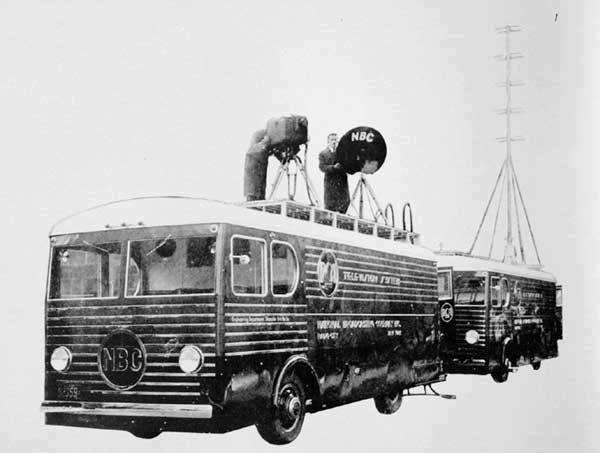
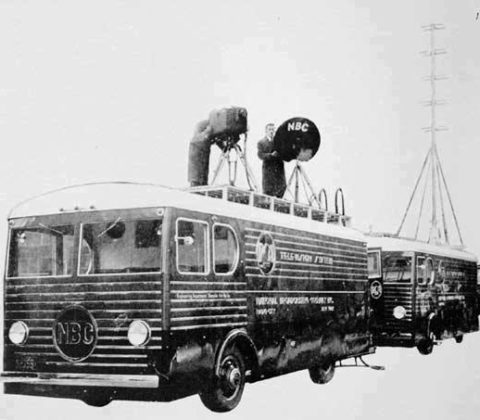
December 12, 1937…America’s First Mobile Units Delivered
On December 12, 1937, the world’s first electronic television remote units were delivered by RCA to NBC in New York City. The dual vehicle system, consisting two, 26 foot buses included one for production and one for transmission.
The production bus provided two portable single-lens Iconoscope cameras and the support equipment. The transmission bus contained the transmitter with a 50 foot antenna which could relay a remote pickup to the Empire State Building from as far away as 25 miles.
The units were field tested for about six months before being returned to RCA’s Camden plant for modifications in the synchronizing equipment. Another modification was the installation of an coaxial feed out the transmitter truck, which allowed them to shoot at 30 Rock’s sunken ice skating rink.
The trucks came back in late August, and on September 15, 1938, W2XBS began a weekly series produced entirely from the trucks. The “Man On The Street” show interviewed passers-by at different locations each week up until the 1939 World’s Fair opening in New York. By the time the World’s Fair came to town, NBC had a lot of experience with the units and used them heavily there.
Also shown here is the world’s first color mobile unit, which used one of these original 1938 trucks as part of the experimental field testing of color broadcasting. Although the interior had been totally retrofitted with all new color equipment, the use of one truck was now possible becuase of new, improved microwave equipment. The date for the conversion is early 1951.
I have seen photos of these trucks with RCA TK30s, which would put them in use in 1946, and I suspect they were used locally as a black and white unit until NBC bought new, larger bus units around 1950. Unfortunately, no one knows what became of them. -Bobby Ellerbee
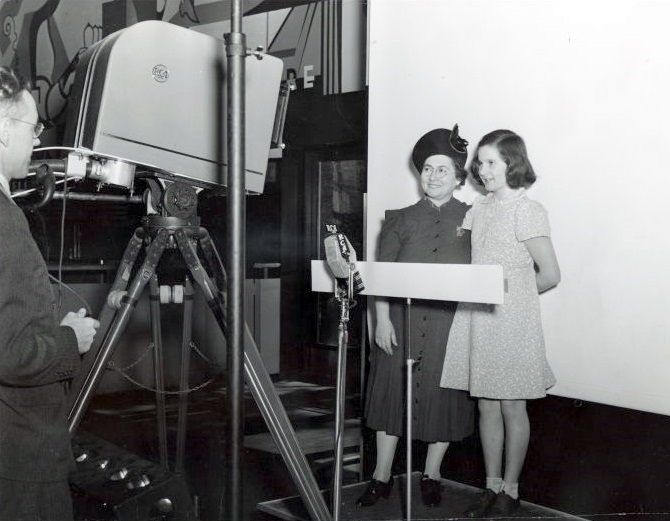
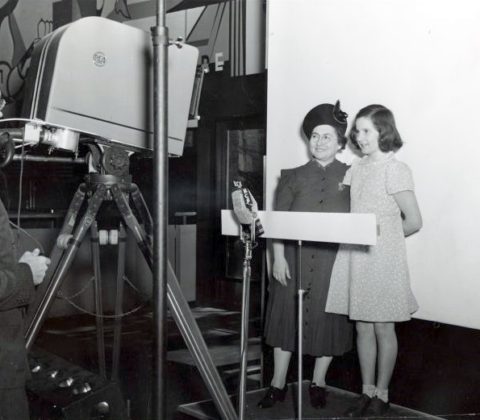
NBC Tour Book: 1939 World’s Fair…America’s View of Television
The first big push to bring television to the public’s attention was mounted by RCA at the 1939 World’s Fair in New York. This is a rare survivor…the 32 page tour book handed out at the RCA Pavilion, that attempts to cover many aspects of the new media. It is packed with rare photos and maps, that even show the Alexanderson Mechanical Disc Camera from the early 1920s, and the later version of that technology, complete with the famous Felix The Cat scanning camera on display. Enjoy!
Studio 8H and the Chapman crane
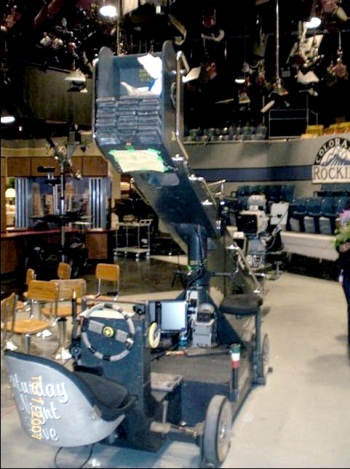
Among the very few things that have not changed since Saturday Night Live debuted in 1975 are the studio it originates from, and the constant use of this Chapman Electra stage crane on the show. We’ve all seen it a thousand times, but never like this before.
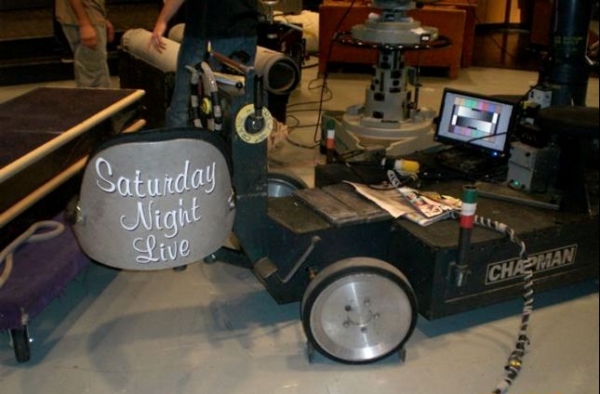
Above is the driver’s seat, and you can see the flat panel monitor that shows the driver the camera feed as the crane is moved. Only the rear wheels turn to steer, and you can see the brake pedal that stops the battery-powered rig. Below is the view from the driver’s seat up the boom arm, showing the boom operator’s monitor.
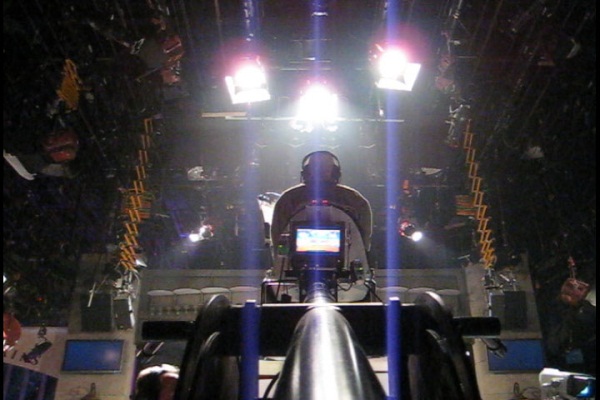
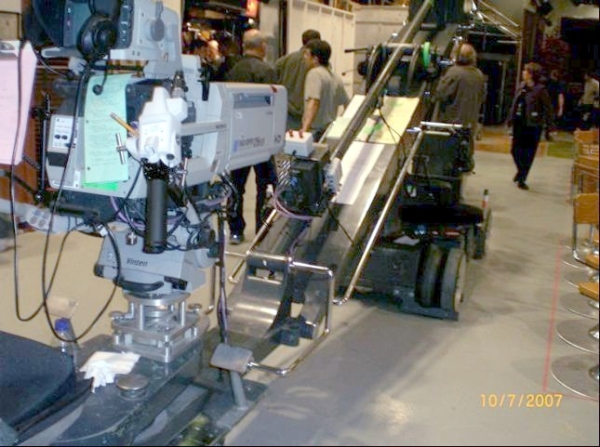
Above, we see the camera operator’s perch and the foot controls used to turn the turret plate the camera and seat are mounted on, which rotates 360 degrees. Below is another great shot of the camera turret with the boom all the way up. Can you say “catbird seat”?
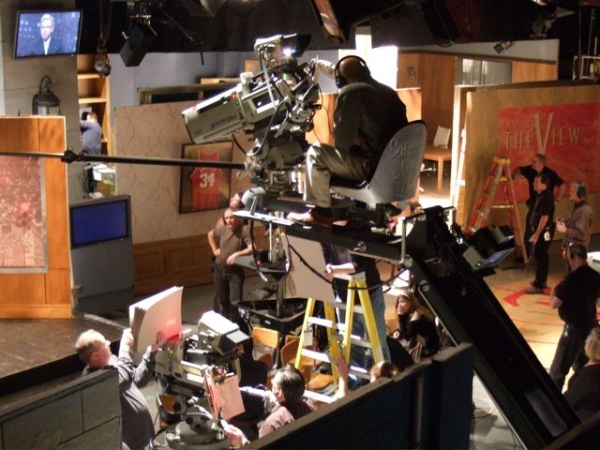
SNL comes from NBC Studio 8H on the 8th and 9th floors of 30 Rockefeller Plaza. As pictured below in this 1939 Life article, 8H was built in the 1930s as a radio soundstage, and originally seated 1250 people. Promotional materials of the day often called 8H the “auditorium studio.” Its most famous tenant was Arturo Toscanini and the NBC Orchestra. In 1950 it was converted to a television studio.
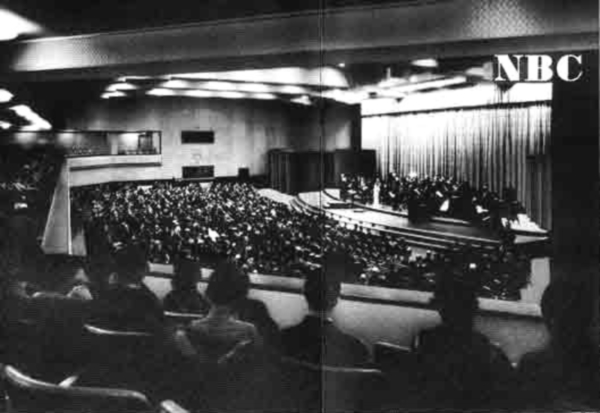
When the show started in 1975, it was decided SNL would originate from 8H. There needed to be a crane for all the frenetic movement in this very busy show, and the Chapman Electra was selected. It has called 8H home since 1975, but it is occasionally used in other studios because when the boom arm is removed, it can fit in the NBC freight elevator to move between floors.
Although 8H has been SNL‘s home since ’75, it too is also used for other productions and events, such as the Summer Olympics from China in 2008. Below you see you see two photos of the 8H studio floor covered with temporary announce booths. Each booth has a producer’s room and a larger announcer’s room where two or even three announcers watch the live feeds from China and add their commentary.

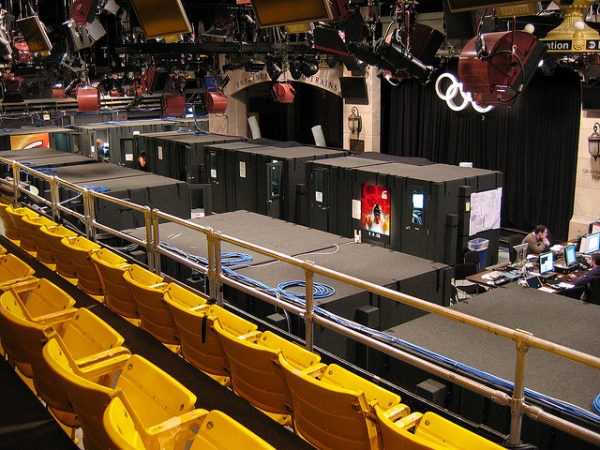
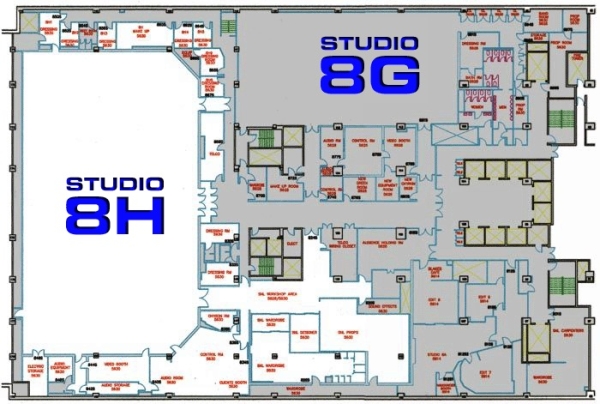
As you can see in the diagram above, 8H and 8G are side by side. Occasionally, the Chapman works there for projects like national election coverage. Below are two shots from 1978 showing Studio 8H in preparation for a new season of SNL (top) and in 8G, the new election set is getting final, last-minute touch-ups and making ready for camera rehearsal (bottom). With so much action in SNL broadcasts, crane shots are essential, but even in situations like election coverage, the unique visual aspect they offer makes a big difference by adding motion abilities the pedestal cameras can’t. Crane shots make static shot situations more fluid with even a small degree of movement.
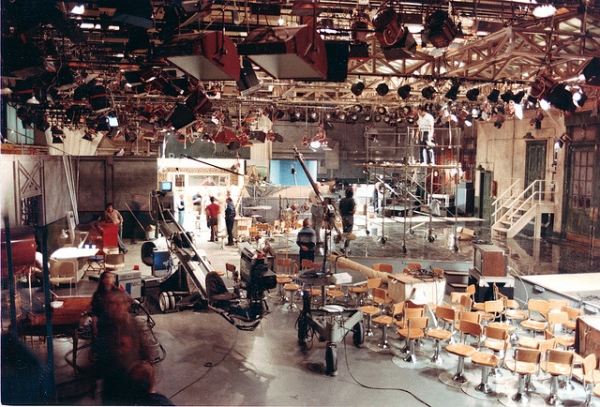
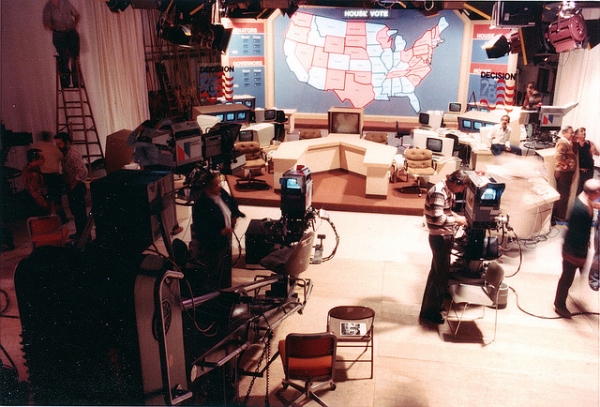
Now, it’s time to take a closer look at where the rubber meets the road – literally! Notice the front wheels have two sets of wheels: one set pneumatic and one set hard rubber. The back/steering wheels are single hard rubber wheels. The reason for the dual-form tire arrangement is to give the smoothest possible ride. The single front hard rubber tire gives a firm ride and single front pneumatic gives a softer ride, but together, they give the best possible “Goldilocks” ride: not too hard, not too soft. I’m sure the cable guards come in handy, too.
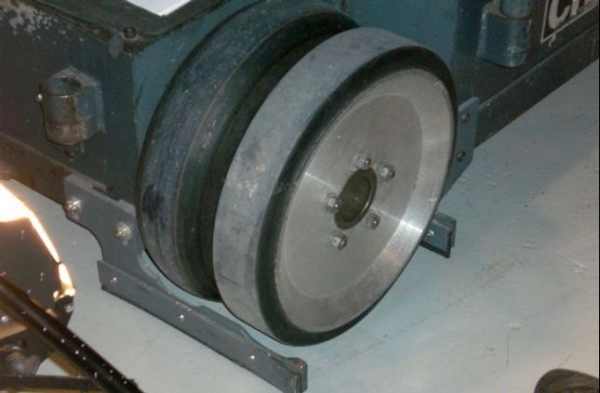
Operating the crane is basically a three-person operation requiring a driver, a boom arm operator and a camera operator. Below is an amazing time-lapse video of Saturday Night Live in production. Much of it was shot from small cameras mounted on this crane. Interestingly, there are two boom arm operators.
I’ve said on other pages of this site how glorious it must be to run the camera on a Chapman…sheer fluidity and grace in motion. Speaking of motion, here is a schematic that shows this crane’s motion capabilities.

Now, here of some shots of what feels like an old friend…one we’ve known for years. I’m sure many of us would love an hour in John Pinto’s chair. He’s the cameraman, and we’ll meet him below.
The camera shown is a Sony HDC 1500 in the Sony HDLA 1505 build-up kit. In the images below, you’ll see the camera folded back into the boom arm while it’s not in use.
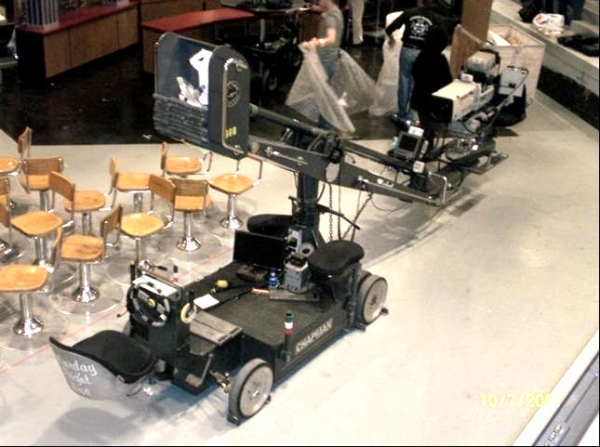
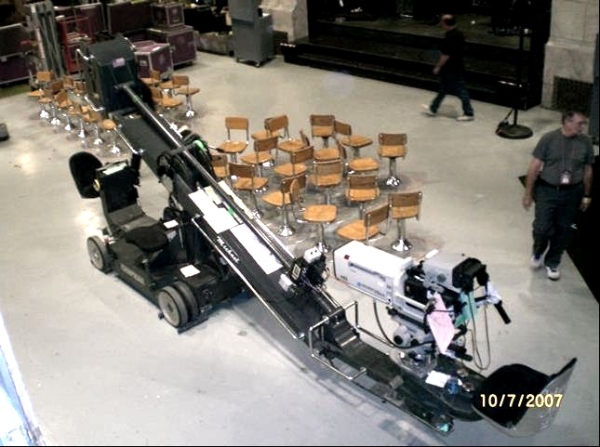
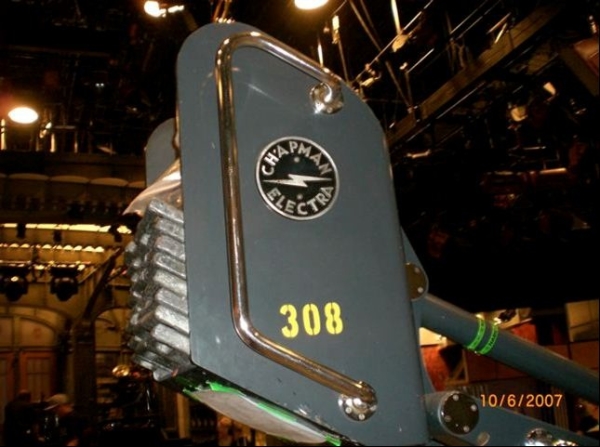
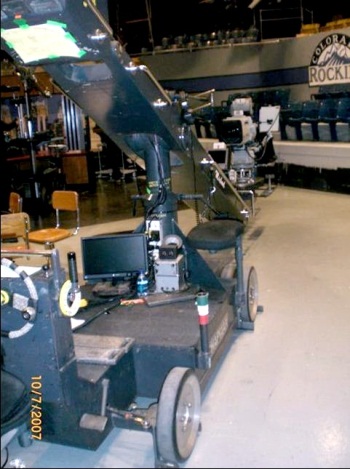
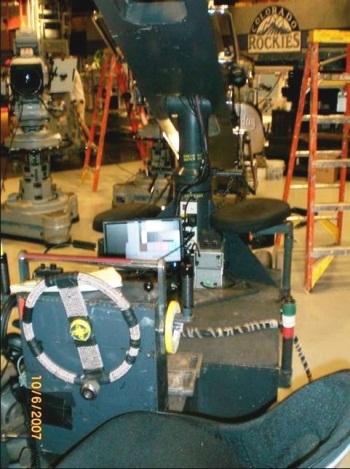
Now that we’ve met the Chapman Electra, let me introduce you to one of the luckiest men in television…the man who gets to ride it. Meet John Pinto.
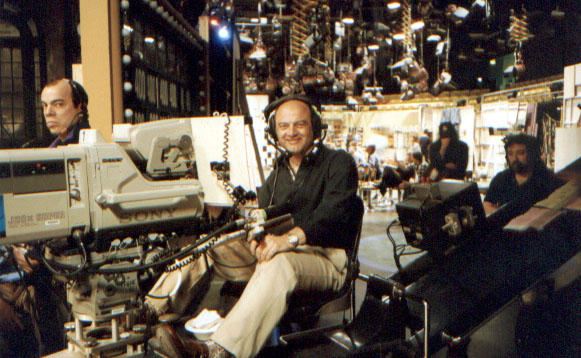
In 1975, the show Lorne Michaels and Dick Ebersol were developing became a reality. Aside from casting the “Not Ready for Prime Time Players,” the staff casting was going on too. NBC set out to recruit a hip, young, but professional crew…and got it. Among those hired were John Pinto, who was at ABC, and Jan Kasoff and Al Camoin, who were at NBC’s Brooklyn studios, and they stayed for many years. John is still there, but more on John and Jan below.
The first camera in use on SNL was the TK44. Below, we see one on the Chapman, possibly operated by Al Camoin, the original crane cameraman.
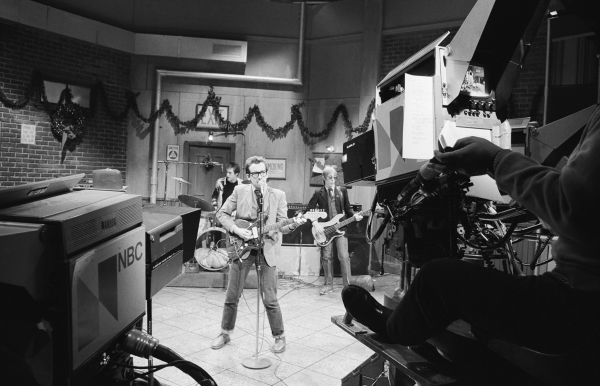
The next camera in use at SNL was the TK47. Below are two shots of a 47 on the Electra, with John at the controls.
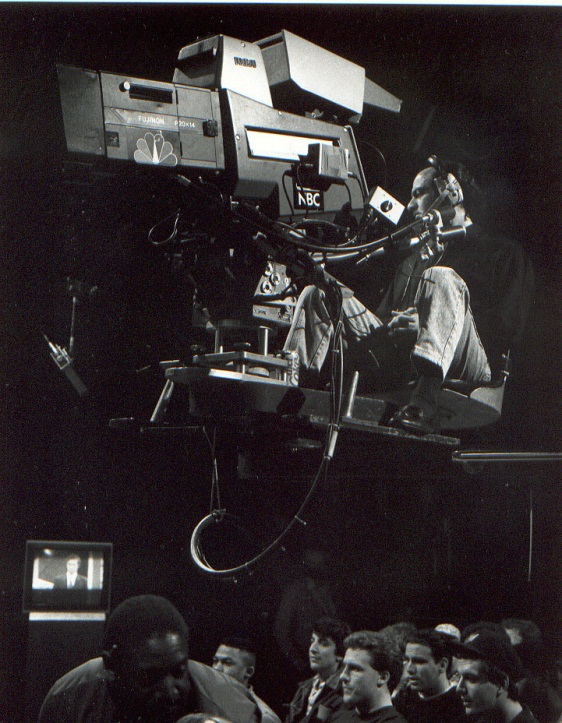
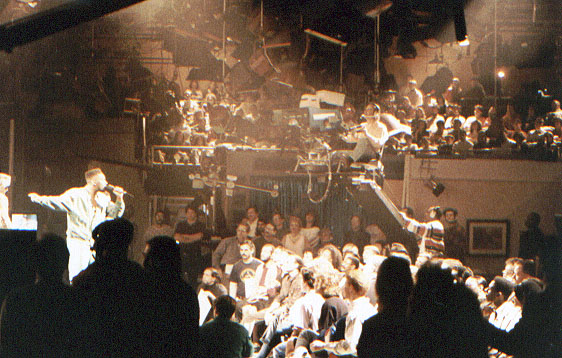
I wanted to put this next image further up the page, but held it for here so I could make the comments I want without veering from the Chapman story too much. Now I can say what I was thinking when I first saw the image below, and what it reminded me of.
Before you read further, please take a moment to really look at this photo and see if you see what I see.
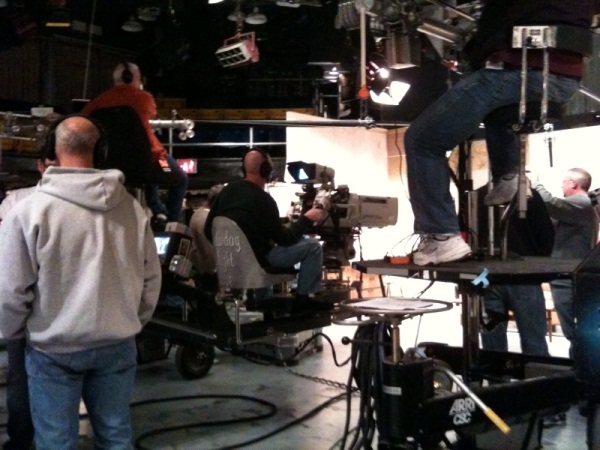
At first, I saw just the camera. But then, to my amazement, I also saw perambulators…yes, sound booms. Two of them! Did you notice them in the pictures above? No? Neither did I, but they are there if you look. Then, a shoe dropped.
I thought, wow. How did I not notice the use of these pieces of equipment that were so vital to television just yesterday, but so unique in studios today? Then the other shoe dropped…the big one. Do you have any idea what that epiphany was?
The people! If you visit almost any local TV station these days, the only people you’ll find in the studios is the talent, and maybe a floor director. Yes, there are news cameramen in the field with ENGs, but robotic pedestals and wireless mics have killed the studio crews.
Thank God there’s still production value at SNL that only skilled and experienced humans can satisfy. Only the networks are keeping the art of camera work alive in the studio and in sports. Thank you!
That is not the first time that has occurred to me. It’s one reason for creating Eyes Of A Generation: to memorialize and pay tribute to the behind-the-scenes people…and to all of you, past and present, thank you!
Many thanks to Greg Hill for the images and information. Greg is Operations Manager for Chapman – Leonard, the world’s leading name in cranes and camera support since 1945. Thanks also to Dennis Degan for his great images of 8H, and to the NBC staff in New York who helped with some background details, including John Pinto and Jan Kasoff. You’ll meet Jan below.
One final note on cranes. Just so we don’t forget the Electra’s predecessors at NBC, I’m adding these images.
Below top is the Sanner studio crane. I think this debuted around 1948, just after the TK10/30 came out. The picture from WKY in Oklahoma City was taken in 1950 and by then, they were in wide use at well-heeled local stations and at the networks. CBS used them in New York longer than NBC, but as you see below, one of NBC’s Sanners is hard at work on Your Show Of Shows with Sid Caesar. RCA listed this Sanner in its catalog as the TD-6A.
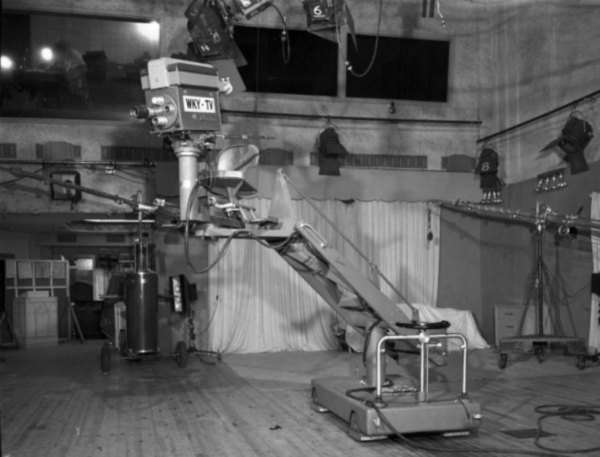
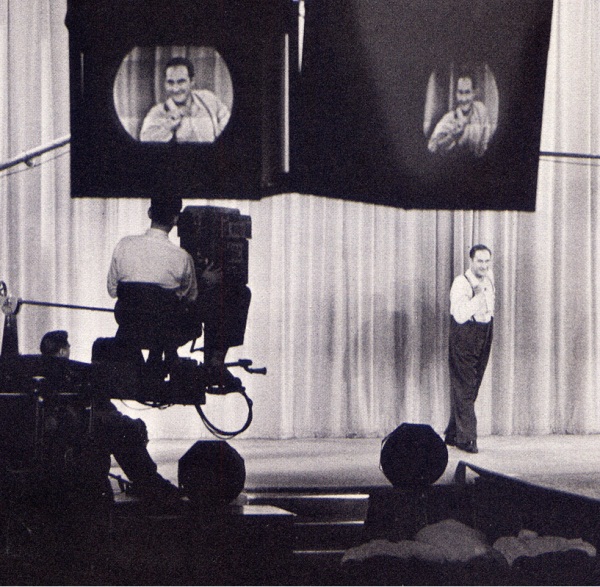
Below, the great Houston Fearless 30B stage crane that I think came out around 1954, and was built to handle the weight of the new color cameras.
NBC had several of these at 30 Rock, at the Brooklyn I and II studios, and at the Ziegfeld Theater for Perry Como. Burbank had several, too. NBC went to the 30B much earlier than CBS, probably because NBC had a lot of TK41s and CBS did not. I’ve never seen a TK41 on a Sanner, and don’t think it would bear the weight. When CBS added color at Television City, the network bought several 30Bs and used them under the TK11s, too. I think the 30B is beautiful – it kind of has an art deco look to it.
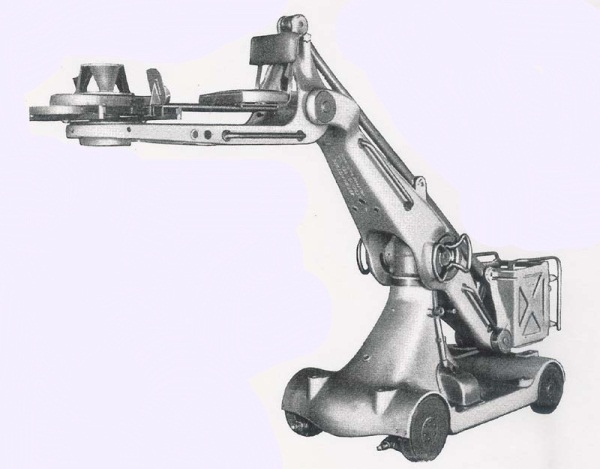
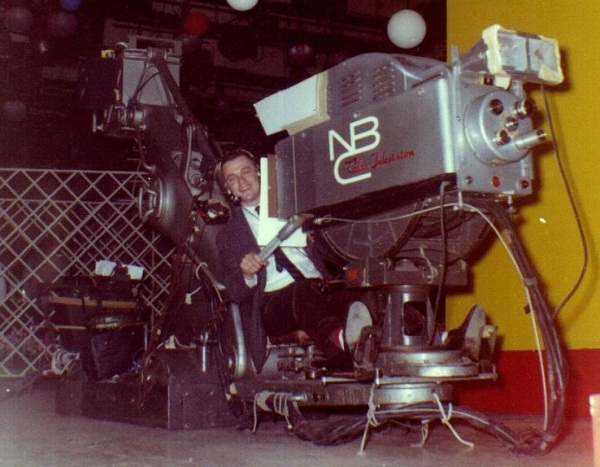
Above is 36-year NBC veteran cameraman Jan Kasoff. His TK-41 is mounted on an HF 30B in use at NBC’s Brooklyn studios in a photo from around 1968. Jan started full-time with NBC in 1967 and until 1978 he worked on soap operas, game shows, sports, news and more. Jan did his first Saturday Night Live in 1977 to cover for a cameraman who was out. He was asked to do SNL as a regular in ’78 and continued there for the next 26 years as a permanent member of the SNL crew until he retired in 2001.
After a six-month hiatus Jan came back to do the show for another year and a half until he became a Florida snowbird. He did his last Saturday Night Live in March 2003. After his second retirement, NBC continued to ask Jan back at busy times; he would return to work NBC Nightly News and other programs. He did his last assignment for NBC in November 2008, when the Florida winters became just too good to pass up. Below, we see Jan on the SNL set just before show time.
Jan got his start by doing what a lot of us used to do: apprenticing. He was around The Perry Como Show set at the Ziegfeld Theater in New York a lot and made himself useful to the staff and crew. He was raised on the TK41s and was one of NBC’s top color cameramen. That camera brings back a lot of fond memories for Jan, and he would just love to have one in his den, but don’t mention this to his wife. (If she complains, Jan, tell her you want the crane, too. That should do the trick.)
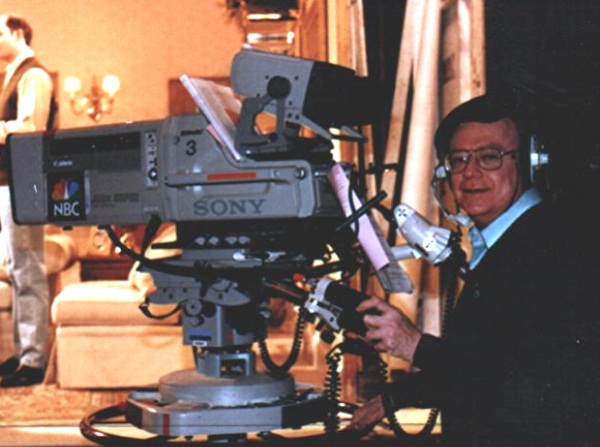
One final thing. Here is a table of productions done at NBC New York, showing the studios they come from and some interesting notes. Thanks to Wikipedia.
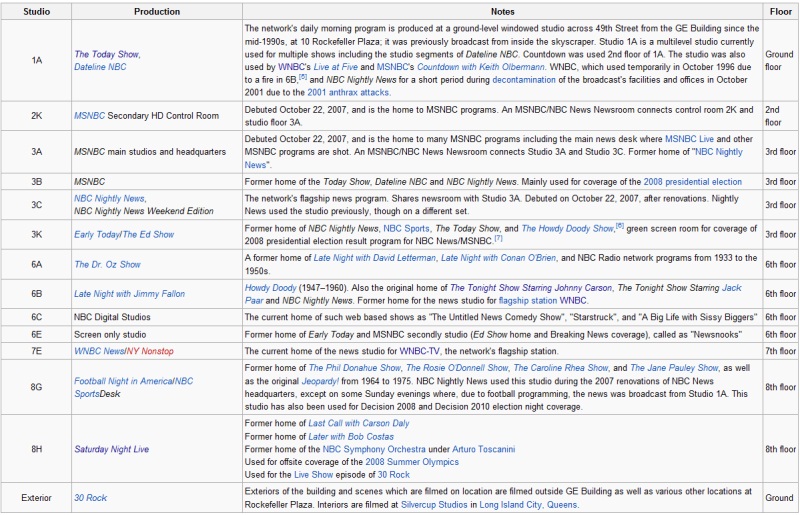
The Birth Of The Camera Mounted Electronic Viewfinder
With all of RCA’s incredible advances and discoveries in television, you would have thought that they would be the ones to put an electronic viewfinder into a television camera, but no…they weren’t. The first production cameras made by RCA and DuMont used Iconoscope pickup tubes but RCA did not add an electronic viewfinder until the prototype versions of their Image Orthicon cameras. RCA had a second optical lens above the taking lens that fed and upside down optical image onto a ground glass plate inside the top of the camera. As you can see below, that could be pretty confusing to the cameraman. For more on the RCA camera click the link. https://eyesofageneration.com/some-little-known-facts-of-early-television-production-yesterday-i-posted-t/
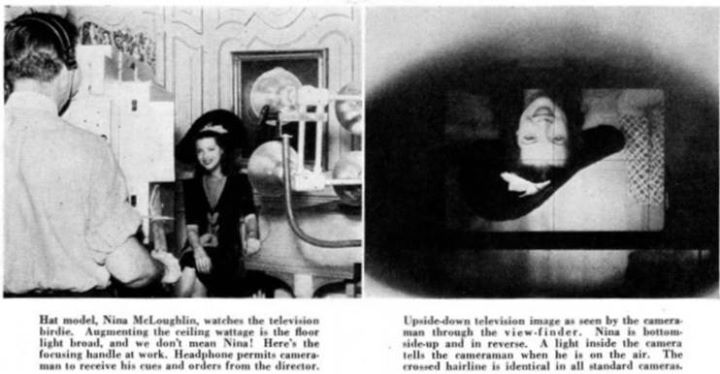
What you will see here is what I believe to be, history in-the-making in this sequence of rare photos that would have been totally overlooked had Barry Mitchell not sent them to me.
I feel pretty sure that what we see here in the photo below, is the first ever image of DuMont’s Iconoscope camera. The DuMont prototype camera.
The photo is of a demonstration of how an electronic television broadcast can go mobile, without even a mobile unit. This photo is from the November 1941 issue of International Photographer Magazine (page 351).
With a setup and body style (https://www.earlytelevision.org/emi_emitron.html) very similar to the BBC’s prewar Emitron cameras, this DuMont prototype camera had only an optical sighting hole. Although you can’t see it here, in the third photo down, you can see a ground glass style viewfinder port on the rear, similar to the RCA style on their prewar iconoscope cameras.
Behind the camera operator is the engineer/utility man and notice that he is looking into an electronic viewfinder (with a veiwfinder hood no less). The photo was most likely taken on the DuMont plant grounds in Passaic N.J., just weeks before Pearl Harbor. As a side note on the date, at this same point in history, brand new NBC Studios 6A and 6B were nearing the end of construction and were being readied for radio broadcasts at 30 Rock.
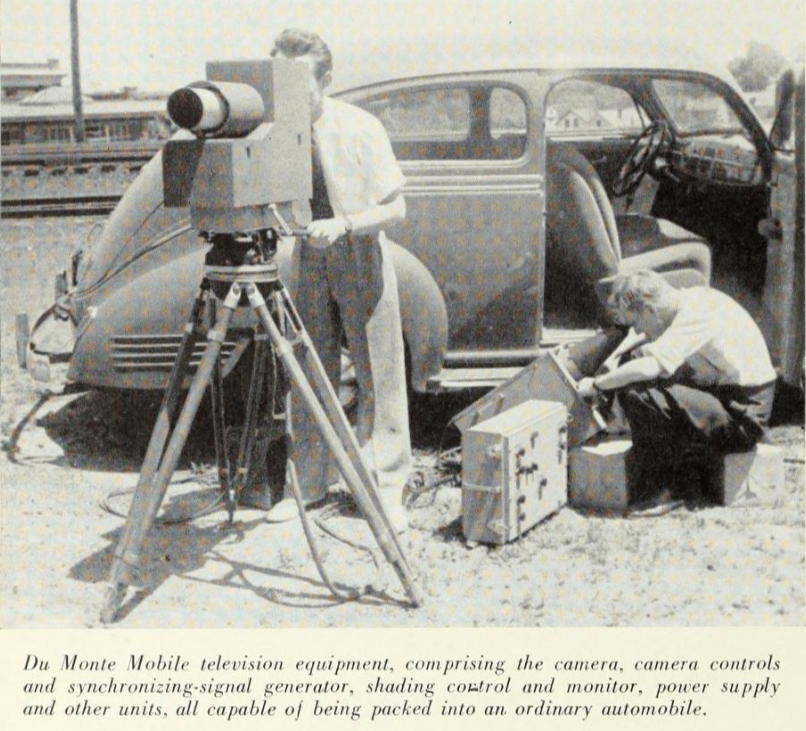
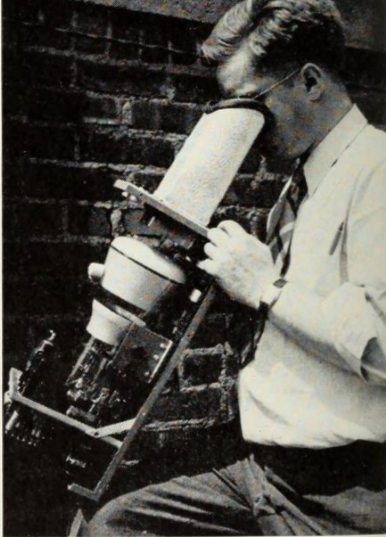
Above is the viewfinder we see in the top photo with the “business end” out of the box. In the box, that is much bigger because of the power supply unit, only the accompanying engineer can see the image which is really not much help to the man behind the camera, but our photo journey continues.
Below is a photo from about a year later (1942 or ’43) that shows DuMont’s new mobile unit that was operated out of their offices and studios at 515 Madison Avenue. Remember, the top photos were taken a month before Pearl Harbor was bombed and shortly after, all electronics manufacturers efforts turned to the war effort…BUT. NBC/RCA, CBS and DuMont all had experimental television stations and DuMont’s W2XWV in New York continued to broadcast on Wednesday and Sunday nights for a few hours.
The image below is most likely from and early evening live broadcast in New York in the summer of 1943. This is most likely the same, single prototype iconoscope camera in the photo above, but notice now, VOILA! The electronic viewfinder is now mounted along the lower left side of the camera, with cords to it’s power supply in the truck in plain site. The next DuMont camera we see will not be this original prototype…it will be their production model that went into service around late 1945 or early ’46.

Below, we have a new casing for the camera and the viewfinder mounted at an angle up the left side for easy viewing and adjustment and in service at DuMont’s KTLA in Los Angeles. -Bobby Ellerbee

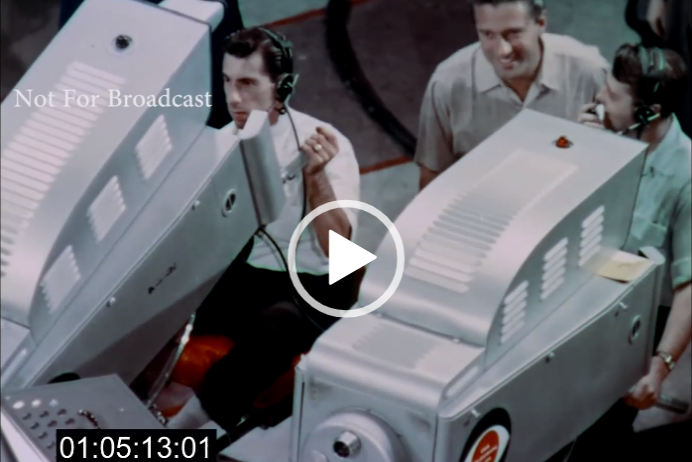
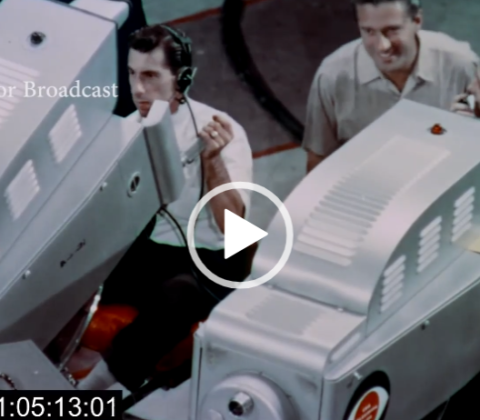
AMAZING CBS COLOR STUDIO 72 NYC…COLOR FILM TOUR
Here is a newly discovered piece of color television history about one of the least known network color facilities…CBS Studio 72 in New York. This is a never aired feature that shows color productions of “The Ed Sullivan Show” and the mystery show “Danger” in 1954.
There are tons of great shots of the RCA TK41s in service and the control room with all the camera control unit apparatus in operation. With the cameras mounted on the old manual PD 1 crank up pedestals and three heavy cables per camera, utility men were a must. BY THE WAY, at the very start, notice the experimental GE mechanical color camera to the left of the introductory speaker. Many thanks to our friend and Game Show Network historian David Schwartz for sharing this.
At the link is a GREAT 24 page CBS Engineering book on CBS Color Studio 72.
https://eyesofageneration.com/cbs-color-studio-72/
ENJOY and BE WELL! -Bobby Ellerbee
A Production Primer By Television’s First Cameraman
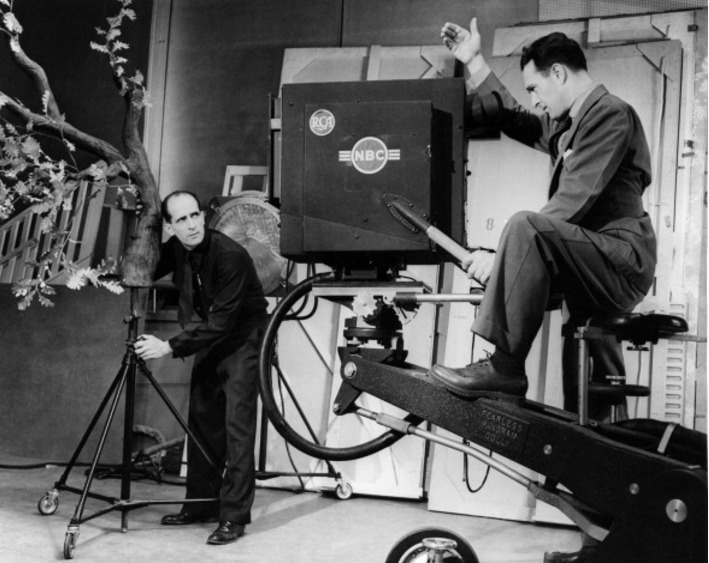
In a photo taken in NBC’s historic Studio 3H, we see Albert Protzman, the first camera person hired to operate RCA’s new all-electronic television apparatus. Studio 3H was the first all-electronic television studio ever built and efforts began by RCA in May of 1935 converted this former NBC radio studio into the epicenter of the world of experimental television in America. Mr. Protzman was there for every step of the way and in 1940 wrote this 15 page article for RCA on just exactly what had to happen for live television to be produced.
By today’s standards, it is very quaint, but remember…this was the very start of television and as Protzman lays out techniques of production, he also lays out the functions of the studio, the control room, special effects, film inserts and more. These are words of a real TV pioneer who, before he retired from NBC in the early 1960s had become of the the network’s top technical directors. Albert’s studio camera partners were (NBC’s second cameraman) Don Pike and (the third cameraman) Heino Ripp who became a legendary technical director in his own right at NBC.
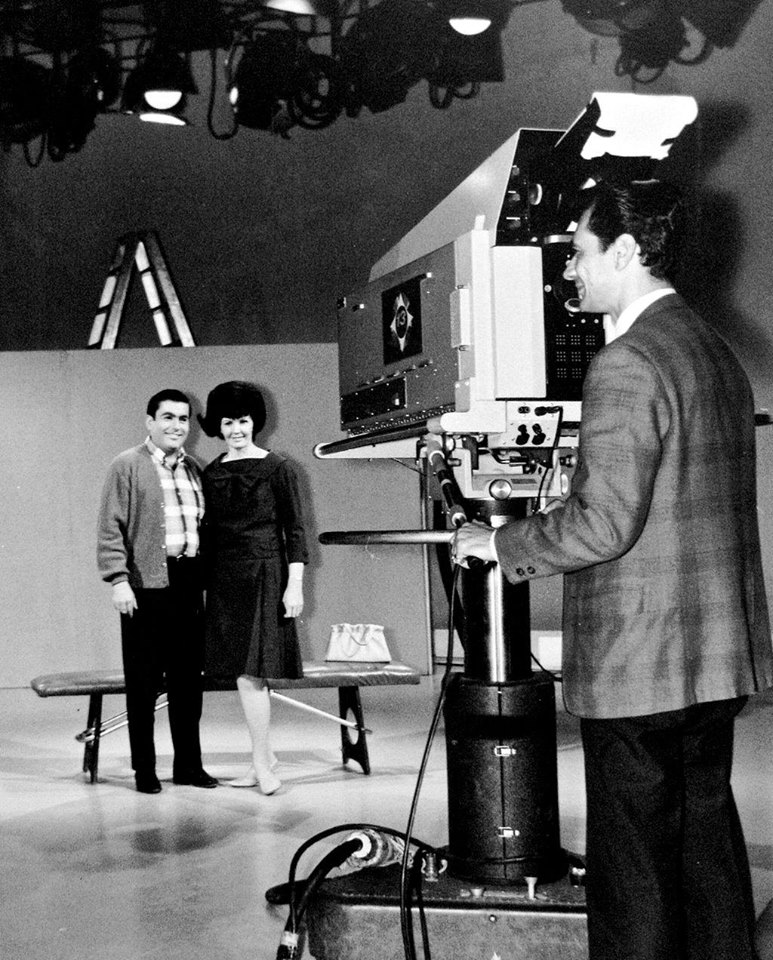
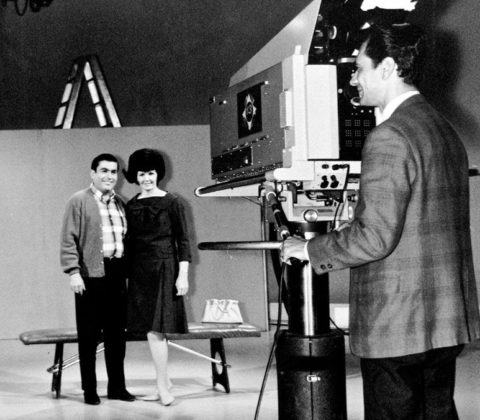
The Rarely Seen GE PE 25 Color Camera
Thanks to our friend Martin Perry, this catalog is the only piece of GE information we have ever seen on this rare color camera. It was preceded by the GE PE 15 model, of which there were less than a dozen made. There may have been as many as 20 to 25 of these PE 25 cameras manufactured and the successor was the GE PE 250. That we know of, there are no PE 25 survivors. Take a look at this rare piece of color history. – Bobby Ellerbee
